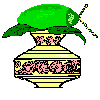

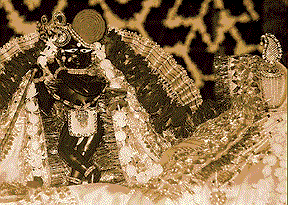



Newsletter
#008
July issue 2005


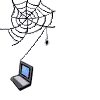
For Silas and Their sevaks
http://www.salagram.net/Sri-Shaligram-Tirtha.htm
mirrored @
http://www.hknet.org.nz/Sri-Shaligram-Tirtha.htm
http://www.silas.alturl.com
or
http://silas.areCool.net
The Nectar
in this Issue
 IN
THIS ISSUE: (click on the hyper-linked underlined
below to jump there...)
IN
THIS ISSUE: (click on the hyper-linked underlined
below to jump there...)

 Intro'
Intro'
 Feature
Article - Advaita Acharya's
temple in Shantipur and the blessings of the Salagram........
Feature
Article - Advaita Acharya's
temple in Shantipur and the blessings of the Salagram........
 Festivals
Coming - Jhulan Yatra, Balaram Jayanti,
Sri Krishna Janmastami, Srila A.C. Bhaktivedanta Swami 108th Avirbhav
Festivals
Coming - Jhulan Yatra, Balaram Jayanti,
Sri Krishna Janmastami, Srila A.C. Bhaktivedanta Swami 108th Avirbhav
 Modes
of Worship:
Modes
of Worship:
 About
the web-site: What's there - how to utilize it.......
About
the web-site: What's there - how to utilize it.......
 New
Entries on the Web-site..... quite a few since the last newsletter
- updates
New
Entries on the Web-site..... quite a few since the last newsletter
- updates
 SEARCH
for Ishthadevatas and Devotees on the site world-wide......
SEARCH
for Ishthadevatas and Devotees on the site world-wide......
 Please
Visit the ARTICLES pages - there's much information to relish there
Please
Visit the ARTICLES pages - there's much information to relish there
 Vaishnava
Calendar - Panjika
Vaishnava
Calendar - Panjika
 Words
of encouragement from HDG
Words
of encouragement from HDG
 Sila
katha - Swadhyaya - glorifying the Lord and His devotees
Sila
katha - Swadhyaya - glorifying the Lord and His devotees
 Shaligram
mahima - part 1
Shaligram
mahima - part 1
 Shaligram
Tattwa Nidhi kosha - Identifying Salagrams
Shaligram
Tattwa Nidhi kosha - Identifying Salagrams
 Salagram seva
in the Sri Vaishnava tradition of South India
Salagram seva
in the Sri Vaishnava tradition of South India
 Hari Prasad
Kemka - Varanasi (Banares - Kasi) and his 65,000 Silas
Hari Prasad
Kemka - Varanasi (Banares - Kasi) and his 65,000 Silas
 Salagram
Kosha - chapter Four - by SK Ramachandra Rao
Salagram
Kosha - chapter Four - by SK Ramachandra Rao
 Correspondence
Correspondence
 - REPORT FROM CAMP SYLET(SRI(Sila)
HATA DHAMA), Bangladesh.
- REPORT FROM CAMP SYLET(SRI(Sila)
HATA DHAMA), Bangladesh.
 - Some great
places to purchase your puja paraphernalia on-line
- Some great
places to purchase your puja paraphernalia on-line
 Advertisements
for Salagram friendly sites
Advertisements
for Salagram friendly sites
 Pilgrimage
to the top of the world - Damodar Kunda
Pilgrimage
to the top of the world - Damodar Kunda
 Newsletters
On-line
Newsletters
On-line
 Wishing
Everyone a Safe & Happy 2005 (519 Gaurabda)
Wishing
Everyone a Safe & Happy 2005 (519 Gaurabda)
 Outro'&
Thanx
Outro'&
Thanx


Sri-murti-lakshana,
aara shaalagraama-lakshana
krishna-kshetra-yaatraa, krishna-murti-darshana
“The characteristics of the Deities
should be discussed, as well as the characteristics of the Shalagrama-shila.
You should also discuss visiting the Deities in the temple and touring
holy places like Vrindavana, Mathura and Dvaraka."
(Sri Chaitanya Charitamrita
Madhya-lila 24:335. text - 61 Explanations of Atmarama verse)

"In the material world also, wherever the Supreme Lord
is personally present is to be understood as being the spiritual world.
For example, the Lord is worshipped in the temple by pure devotees. The
Temple is therefore to be understood as being the spiritual world." (Srimad
Bhagavatam 4.11.26 Purport)

"The Lord in the temple in the worshipable form is never
to be considered to be made of stone or wood, for the Lord in His arca
incarnation as the Deity in the temple shows immense favor to the fallen
souls by His auspicious presence. By the hearing process, as mentioned
hereinbefore, this realization of the presence of the Lord in the temple
is made possible."
(Srimad-Bhagavatam, 2.3.21, Purport)


 ...Intro'
...Intro'
Hare Krishna
Namaskaragalu - Vanakkam - G'day
Please accept my respectful obeisances,
All glories to Srila Prabhupad, All glories to Sri Guru and Gauranga,All
glories to all the Vaishnava devotees of the Lord
Chari Vaishnava sampradaya ki jaya
Sri Swayam-vyakta Shaligram Sila, Dwaraka
Sila, Govardhan Sila ki jaya
Welcome to what we hope to be the eighth
of many newsletters. The present plan is to attempt to maintain the site
nicely and keep updating with new information and pictures and additions
to help enthuse everyone, and use this newsletter to help keep everyone
informed about that. With my other various services we figured that Quarterly
would be a feasible beginning, so we are looking at April - July - Sept
- Dec for now.
So we went a bit off from that with
unforeseeable situations occuring, my having to be away from my system
for a few months and losing my old faithful computer's contents to hacker's
attacks. Then my son paid for me to go to India with him, so there was
another couple of months away, but wow was it worth it all.
Yes, it has been a rather eventful
year with many things happening. We have experienced many new things, learned
many new things, welcomed many new friends, and met some old ones too -
as some wise sage once said "There are no strangers, only friends we have
yet to meet !" So that has become manifest as many devotees unknown to
me previously wrote in and sent pictures of their worshiful Lords. We too
by the mercy of the Lord and His devotees have received a few new additions
to try to render some seva to.
As Krishna consciousness is ever expanding
and ever deepening we would like to expand this service to you all so as
to receive your blessings. Therefore we very much welcome constructive
feedback to further assist the development of the site and newsletter services
- always open to that.
Sri Krishnarpanamastu - respectfully
in the service of the Lord.
yhs, JTCd


Festivals
Coming Soon
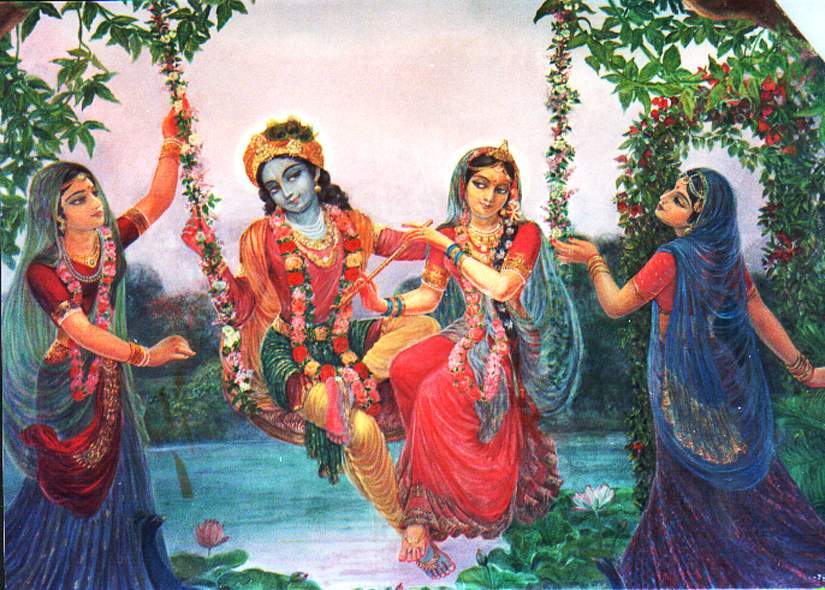
Sri Sri Radha Govinda Jhulan
Yatra - Swing Festival
16th August 2005 in NZ
(please check with your local temple
or panjika)
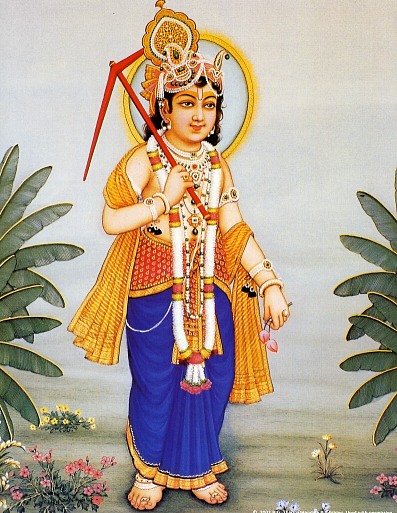
Appearance Day of Lord Balaram
Fasting 'till noon
19th August in NZ
(please check with your local temple
or panjika)
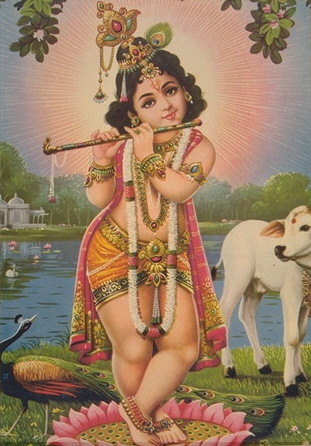
Sri Krishna Janmastami
27th August 2005 in NZ
(please check with your local temple
or panjika)
(fasting until midnight grain free breakfast)

Srila A.C. Bhaktivedanta Swami Prabhupada's Avirbhav
Sri Vyasa pujan mahotsav
The 108th ANNIVERSARY CELEBRATION
of the appearance of
His Divine Grace
A.C. BHAKTIVEDANTA SWAMI PRABHUPADA
http://www.prabhupada108.net/
1896 – 2004
Founder Acarya of the International Society for Krishna Consciousness
Celebrated By
The International Society for Krishna Consciousness
The year beginning on Prabhupada's Vyasa Puja September
6th, 2004, and ending with his Vyasa Puja on August 28, 2005 marks the
108th anniversary of his birth. While everyone honors 100th anniversaries,
Vaisnavas place great significance on the 108th anniversary, because 108
is a special number. Krsna enjoys with 108 principal gopis (cowherd girls),
there are 108 Upanishads, and a round of japa on beads is 108 Hare Krsna
mantras. ISKCON has created a special opportunity to glorify Srila Prabhupada
on his 108th birthday and throughout the year afterwards. ISKCON's governing
body commissioners in their annual meeting this year passed the following
resolution.
Whereas: The 108th anniversary of Srila Prabhupada's appearance can
bring special inspiration to the devotee community by glorifying Srila
Prabhupada.
Whereas: H.H. Lokanath Swami was successful in performing the service
of Srila Prabhupada's Centennial Global Minister.
Resolved: ISKCON will make the celebration of Srila Prabhupada's 108th
appearance anniversary year a highlight of its activities until Vyasa Puja
2005. H.H. Lokanath Swami will take up the service of global coordinator
for this project.
In 1996 ISKCON celebrated Srila Prabhupada's Centennial.
Participation in events far exceeded expectations. Throughout the
Centennial year, followers of Srila Prabhupada made extraordinary efforts
to spread his glories world wide by inundating their countries, states,
and cities with the holy name of Krsna, Krsna prasadam, and Prabhupada's
books. Temples world wide joined in celebrating many spectacular
special events. Streets were named in Prabhupada's honor, and several
biographies about him were published. There were also many wonderful
special achievements and offerings by individuals and groups. but
why was the Centennial so successful? We could only conclude that
it was because Krsna wanted to glorify Srila Prabhupada. Krsna wanted
to show the world that He is know as bhaktanama mana vardhanah, "He who
enhances the reputation of His devotees."
Srila Prabhupada's teachings, which continue to
be felt throughout all parts of ISKCON, are the universal inspiration for
the 108 celebration. All initiated devotees and all followers of
Srila Prabhupada have a high level of awareness, appreciation, and remembrance
of him. They feel connected with him as their siksa guru, accepting
as essential the teaching he gave in his books. Inspired by his powerful
presence, they follow his instructions in their own lives and are able
to bring others to follow them too.
The celebration of Srila Prabhupada's 108th
anniversary will focus on a series of public events. most of the
international events that were so successful in 1996 will be held again.
The events will bring about a heightened appreciation for Srila Prabhupada
and his movement in the public and increase ISKCON's member's awareness
of being part of a united worldwide movement.
The 108th Celebration is not limited to events.
The spirit of the Celebration is to encourage each ISKCON devotee, member
and follower to make at least one personal offering to Srila Prabhupada
during the year in one or more of the following areas:
1. Help spread Srila Prabhupada's mission by expanding the congregation,
distributing books and chanting the holy name, especially at 108 events.
2. Dedicate oneself to glorifying Srila Prabhupada by personally meaningful
special achievement during the 108th year.
3. Build personal internal strength by commitment to improving both
personal spiritual standards and practices and those of your community.
The 108th Celebration is a great time to introduce
the whole world to Srila Prabhupada and his mission. Let us all take
seriously this very special opportunity, and wholeheartedly glorify Srila
Prabhupada.

 ...Feature
Article:
...Feature
Article: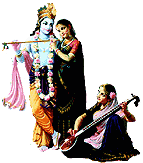

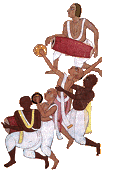
(To view some of the texts on this
newsletter you will need to have the Balaram font installed on your system.
You can download it for free HERE and then go to
Start, settings, control panel and Fonts and Install New Fonts)
In the last issue of our newsletter SSTP#007
there was an article called Advaita Acharya invokes Lord Chaitanya to
appear through worshipping the Salagram sila: so in this issue we had
to take it one step further by presenting more information on that Salagram
in Shantipur, West Bengal. One devotee Sikhi Mahiti prabhu ACBSP paid a
visit to the temples directly connected with the pastime where Arila Advaita
Acharya invoked the Lord, he got pictures of the Salagrams and the temples
also. For Gaudiya Vaishnavas this has to be one of the most important Salagram
silas, as you will read in the words below.
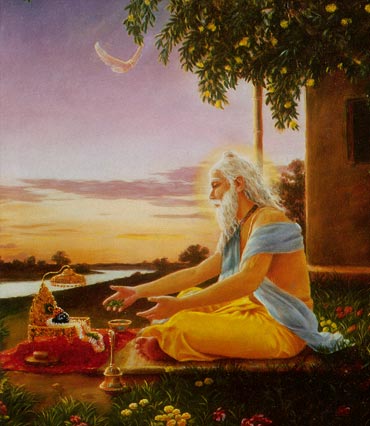
From Sikhi Mahiti prabhu:
Haribol Prabhus,
There are two temples in Shantipur. One is in the village where ISKCON
participates in the Shantipur festival on the disappearance day of Madhavendrapuri.
And, the other temple is in the city. These pictures were taken the next
morning in Shantipur after the festival.
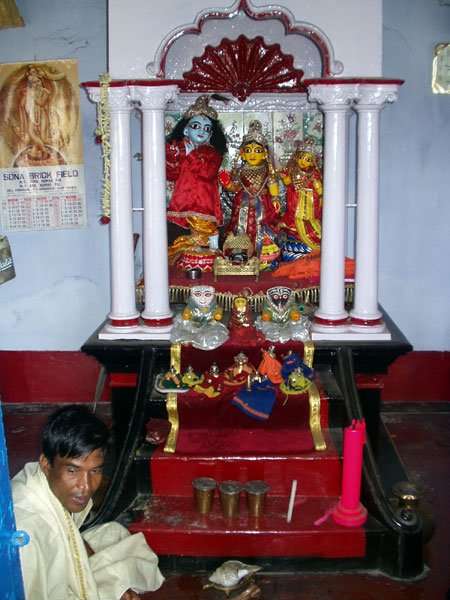
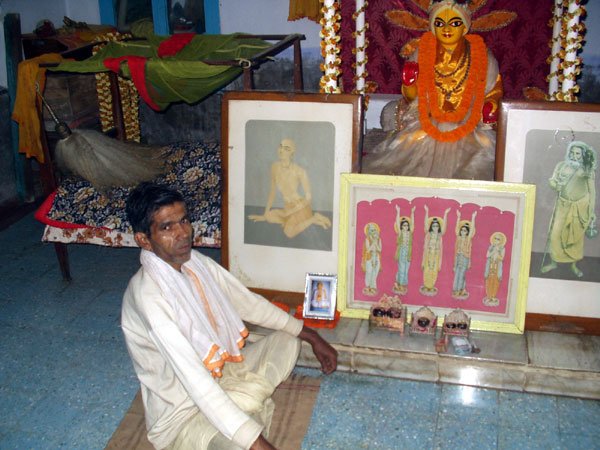
Shantipur City temple  Shantipur
village temple
Shantipur
village temple
While attending the festival 2005, we inquired about the Saligram Sila
that Sri Advaita Acarya worshiped to call Lord Caitanya. The priest, a
descendant of Advaita Acharya, said that the saligram was buried under
the altar 200 years ago for it's protection. I didn't believe the story
so I returned the next morning after mangal arati with His Holiness Amilavilas
Swami. He spoke with a different pujari who agreed to bring the saligram
silas out for us to see. They are not on the altar for darshan normally.
The picture with the two nrsmhadeva silas and three others are from the
temple in the village. The pujari said that one of the two nrsmha silas
has responsible for the descent of Lord Caitanya. The pujari gave us the
tulasi leaves from the saligrams as prasadam. We honored some of them,
and I took one home and put it on my altar. I also had brought my Bala
Gopal sila and the purjari bath him along with the nrsmha silas.
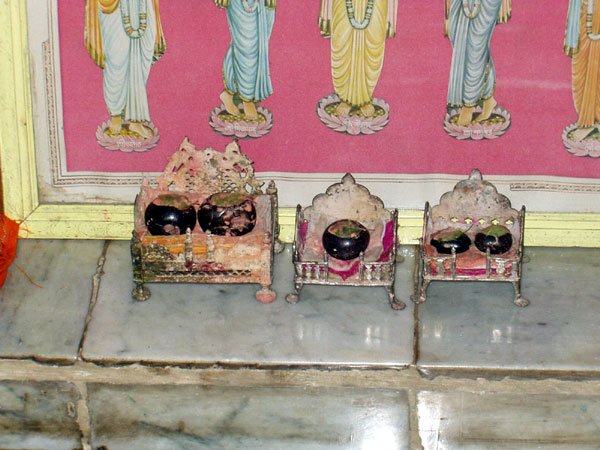
Advaita bhavan Shantipur village temple Salagram silas
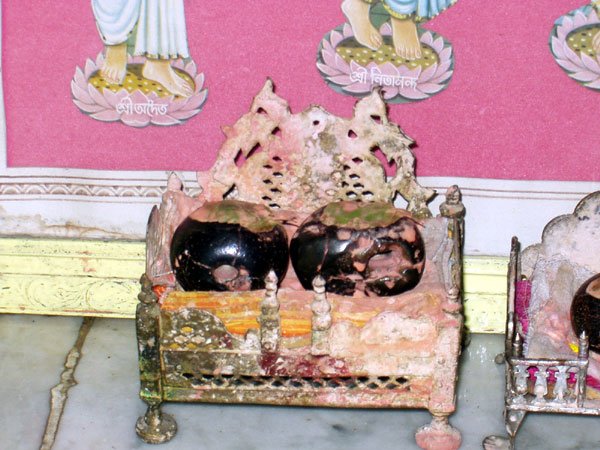
We also visited the Advaita temple in the city. Amazingly, the pujari
there looks just like the pujari in the village. Of course, he is a descendant
of Sri Advaita also. He showed us another nrsmha sila that Sri Advaita
worshiped also. So, one of the three is the one. Or, maybe he is buried
under the altar like the first pujari said.
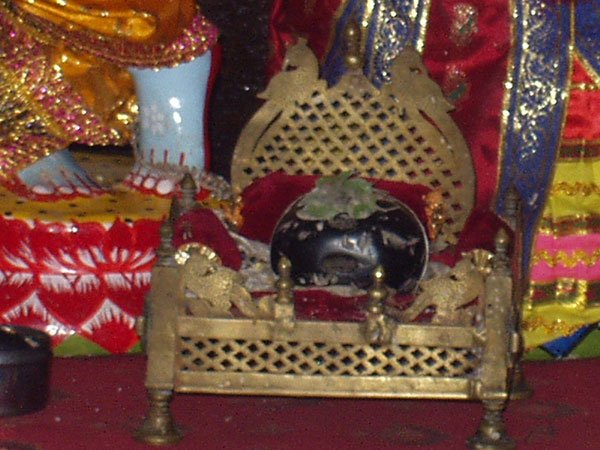
Sri Nrsimhadev from the City temple
The village temple is were Lord Caitanya, Lord Nityananda, and Sri Advaita
would meet to discuss how to spread the sankirtan movement. Srila Prabhupada
would visit this temple during his grhastra days and later as a sannyasi
and pray for the blessing to spread the sankirtan movement in the west.
So, this is a very powerful and Krsna Conscious location. I'll tell that
story at the end of this article.
An interesting point I like to make is that this Nrsmha Sila actually
brought Radha and Krsna together as Sri Caitanya Mahaprabhu. This Sila
gave birth to the Sankirtan movement that we all are participating in today.
Sri Advaita Acharya offered tulasi and ganges water and begged for the
appearance of the Lord to the Nrsmha sila. That sila fullfilled the request
and cause the descent of Mahaprabhu. That is a very special saligram. I
offered my obeisances and beg for empowerment to spread Krsna Consciousness
in the west from that Saligram. I prayed at both temples.
I hope some others can shed more light on the history of this saligram.
The pujari in the city said that an ISKCON matajai spent a few months there
compiling a research paper for her Doctorate in Religion in 2002 or so.
He showed us the book but we didn't have time to read much. I only had
a short time to visit Mayapur this year (2005) and could not return to
discuss more with the pujaris.
Srila Prabhupada and Advaita Bhavan
Sri Advaita Acarya's house is very significant also because Srila Prabhupada
visited there often to beg for empowerment to spread Krsna Consciousness
in the west. In 1980 at our Caitanya Candrodoya Mandira in Mayapur, the
pujari of the temple visited and told the story of Srila Prabupada's visits.
This pastime was told at the Sanitpur festival this year and is also in
the book "Our Srila Prabhupada a Friend to All". It is compiled by the
late Mulaprakrti devi
dasi ACBSP. It is a collection of interviews with people outside of
ISKCON who new Srila Prabhupada before and after he began preaching in
the west. The pastime is as follows.
During the 1940's and 50's, the pujari noticed that one grhastha Bengali
devotee used to come to the temple quite regularly. He was dressed in a
white khadi dhoti and kurta and he always came alone. He would sit in the
back of the mandira without speaking, and he would chant hari-nama on his
mala very quietly and deeply. He would come on weekends, usually once every
month or two. After chanting there for many hours, he would always thank
the pujari and leave. Since his devotion was solitary, the pujari never
disturbed him. The pujari would notice that while he chanted, his eyes
would be full of tears and his voice would choke up.
Then for a long time, he did not come back. However, the pujari remembers
that in August of 1965, he saw a saffron-clothed sannyasi sitting in the
back of the mandira. He recognozied him to be the person from before. Again
he sat for a long time chanting Hare Krsna. He was weeping unabashedly
even more than before while he took the Holy Name. Finally, as evening
came, he paid his dandavat pranama for a long time. When he arose, he came
up to the pujari and thanked him for his seva at Advaita Bhavan. The pujari
asked him, "Who are you? I remember you from so long ago." He replied,
"My name is Abhaya Caranaravinda Bhaktivedanta Swami Maharaja. I am an
unworthy disciple of His Divine Grace Srila Bhaktisiddhanta Sarasvati Thakur,
Srila Prabhupada, my divine master. I have been coming here for such a
long time becasue my gurudeva has given me an impossible mission. His desire
was for me to go across the ocean to the Western countries and spread the
sublime teaching of Sri Caitanya Mahaprabhu. I have not known how this
mission of his will be successful, so I have been coming here to this special
house of Advaita Acarya, where he, Nityananda Prabhu, and Sri Caitanya
Mahaprabhu would gather to plan the sankirtana movement. It was here that
they launched the inundation of love of God that swept India and continues
to this day. Thus, I have been praying very earnestly here that they will
all give me their mercy and somehow they will empower me and guide me.
I want to satisfy my gurudeva's desire, but I am feeling unqualified to
do this."
As he was speaking to the pujari, he saw tears falling down on his cheeks
again. Then he continued, "Tomorrow I am leaving for Calcutta to go upon
a ship across the ocean to America. I do not know what will befall me there,
but I am praying most earnestly here for help." Then, he very humbly asked
the pujari for his blessings.
It was a few year later that the pujari began to noticed, for the first
time, white Vaisnavas coming to Advaita Bhavan. They were wearing dhotis
and saris and chanting on tulasi-mala. The pujari never spoke to any of
them but then one of them gave him a "Back to Godhead" magazine from America.
As the pujari was looking through it, he saw a painting of Srila Prabhupada
label as the Founder-Archaya who brought Krsna Consciousness to the West.
It was a picture of his old friend, Bhaktivedanta Swami, who had come and
prayed there so many times before. He then realized that he had actually
accomplished that impossible mission of his gurudeva. He saw that it was
indeed he, starting alone and without pretense, who had accomplished this
glorious miracle against all odds. As soon as the pujari saw this, he came
to the temple in Mayapura to tell this information.
Jagaguru Srila Prabhupada KI JAYA!!!!
ys,
Sikhi Mahiti das ACBSP
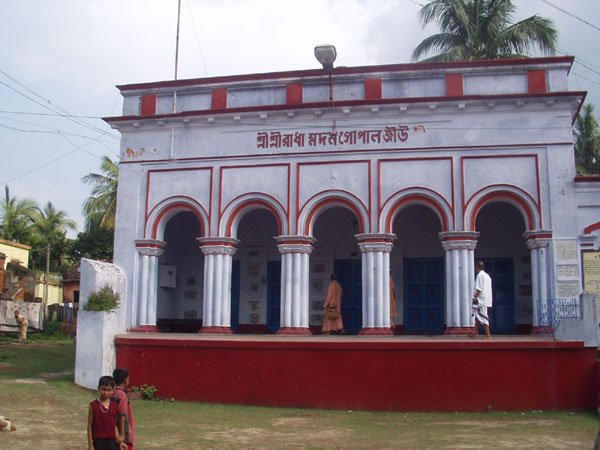
Shantipur City temple
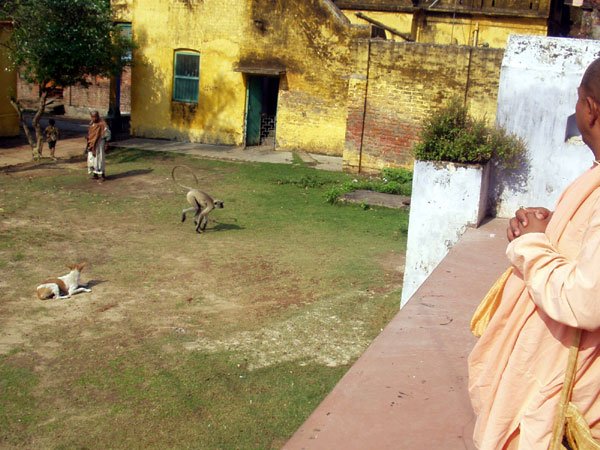
HH Amilavilas swami watching a monkey in the court yard of the temple
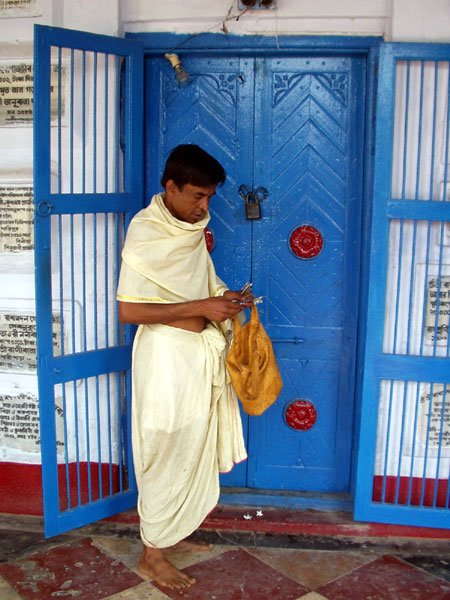
The pujari of the Shantipur City temple
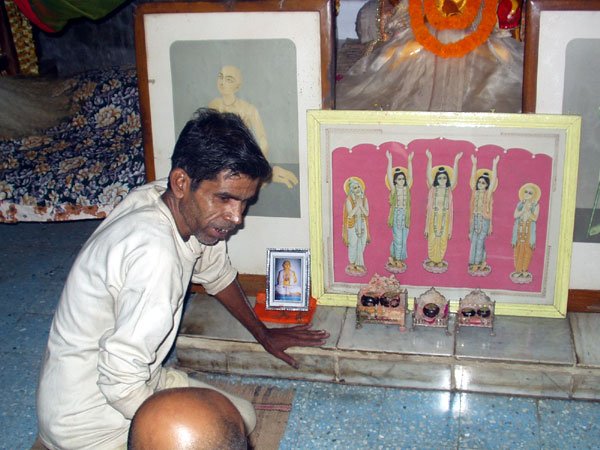
The pujari of the Shantipur village temple talking with HH Amilavilas
swami
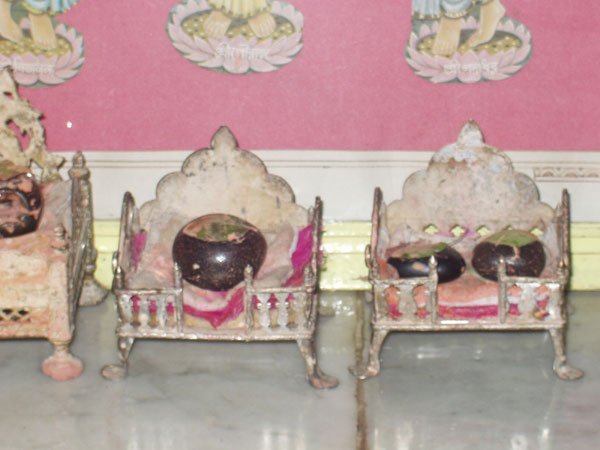
Shantipur village silas
See more about Advaita Acharya here:
http://www.salagram.net/parishad31.htm


yajante sättvikä devän
yaksha-rakshämsi räjasäh
pretän bhüta-ganämsh chänye
yajante tämasä janäh
"Men in the mode of goodness worship the demigods; those
in the mode of passion worship the demons;
and those in the mode of ignorance worship ghosts and
spirits." Bhagavad Gita 17:4.
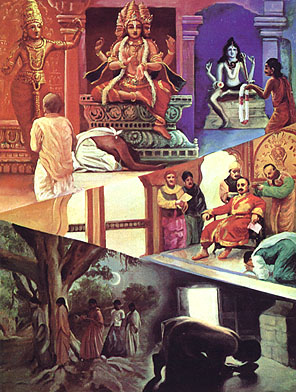
Worshipping the Supreme Lord (visuddha sattwam) and the Devas (sattwa
guna), worshipping powerful humans or demons (raja guna), worshipping ancestors
and ghosts (tamo guna) - worship according to different modes of nature
of the sadhaka.
"Those who are situated in goodness
generally worship the demigods. The demigods include Brahmä, Çiva
and others such as Indra, Candra and the sun-god. There are various demigods.
Those in goodness worship a particular demigod for a particular purpose.
Similarly, those who are in the mode of passion worship the demons. We
recall that during the Second World War a man in Calcutta worshiped Hitler
because thanks to that war he had amassed a large amount of wealth by dealing
in the black market. Similarly, those in the modes of passion and ignorance
generally select a powerful man to be God. They think that anyone can be
worshiped as God and that the same results will be obtained.
Now, it is clearly described here that those who are in the mode of passion
worship and create such gods, and those who are in the mode of ignorance,
in darkness, worship dead spirits. Sometimes people worship at the tomb
of some dead man. Sexual service is also considered to be in the mode of
darkness. Similarly, in remote villages in India there are worshipers of
ghosts.
We have seen that in India the lower-class people sometimes go to the forest,
and if they have knowledge that a ghost lives in a tree, they worship that
tree and offer sacrifices. These different kinds of worship are not actually
God worship. God worship is for persons who are transcendentally situated
in pure goodness. In the Çrémad-Bhägavatam (4.3.23)
it is said, sattvaà viçuddhaà vasudeva-çabditam:
“When a man is situated in pure goodness, he worships Väsudeva.” The
purport is that those who are completely purified of the material modes
of nature and who are transcendentally situated can worship the Supreme
Personality of Godhead." (Srila A.C. Bhaktivedanta Swami Prabhupada. Bhagavad
Gita AS IT IS 17:4. purport.)
"In the material world also, wherever
the Supreme Lord is personally
present is to be understood as
being the spiritual world. For example, the
Lord is worshipped in the temple
by pure devotees. The Temple is therefore
to be understood as being the
spiritual world." (Srimad Bhagavatam 4.11.26 Purport)


 ...About
the web-site: What's there - how to utilize
it...
...About
the web-site: What's there - how to utilize
it...
We have started this web-site and news-letter
for the purpose of sharing inspiration among like minded devotees, with
a like interest in serving the Lord. On the www.salagram.net/ site there
are many topics all referenced to shastra with the express purpose of helping
us all over the world to have Sadhu-sanga http://www.salagram.net/sstp-sadhusanga.html
So we have tried to create a sacred place in Cyber-space where devotees
can find refuge, can associate, gain inspiration, share inspiration, hence
it is Shaligram Tirtha, a Holy Tirtha in Cyber-space. Some of you may have
noticed the Warning........ it seems appropriate to some of us it be there
as many devotees were feeling they didn't want to express themselves or
reveal their "bhav" least people who had no such appreciation might misunderstand
- misinterpret - criticise what they saw or read due to their own vision/motivation/agenda.
So following the advice of shastra we are keeping our Ishthadevas hidden
while sharing mutual appreciation found in rendering some small service
to the Lord.
Those of you who haven't visited the
site recently, or for the many new persons on the mailing list, you will
find transcendental pleasure that there are so many resources and articles,
all of which you are welcome to download or copy for your personal use
and to inspire others. If however you find a published article there that
you would like to publish or if you have a site or some media whereby you
would like to on-share with others just check with me to see who holds
the legal copywrite if none are mentioned, as we don't want to offend anyone,
or do anything illegal, even with our zealousness to share nectar.
If you find any inspirational articles,
or items, or pictures relevant to this site please feel free to send them
to us. Please include all available references and details so that everything
can be appreciated fully by all.
If for some reason http://www.salagram.net/Sri-Shaligram-Tirtha.htm
isn't working or available then please go to the mirror site http://www.hknet.org.nz/Sri-Shaligram-Tirtha.htm
- and please remember to save these URLs in your Favorites (IE) or Hotlist
(Opera) Bookmarks (Netscape).


 ...
...
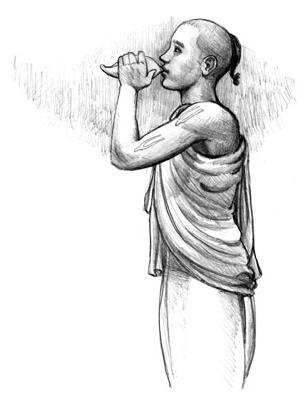
Latest Updates & Additions
@ A Glance
http://www.salagram.net/sstp-NEW.html
last updated 21st July 2005
In this section you can see all the
latest additions, new picture updates of all the various devotees and Silas
on the site.
Recently we had the great good fortune
for our son to buy me a ticket to go with him to India, he took his digital
camera too, so we went on the hunt for Salagrams and Govardhan silas. We
had so much fun especially in and around Vrindavan. There's lots of new
"Eyes Candy" for you all, as well as devotees we met, and even our own
humble page.
We keep this NEW & Updates page
separate from the main SEARCH page
so that regular nectar loving bees can quickly find their sweet flavoured
source in what/Who has been recently added to the site. SEARCH
and ARTICLES links and all other pages
are also updated simultaneously.







 for
Isthadevatas and Devotees on the site
for
Isthadevatas and Devotees on the site
http://www.salagram.net/sstp-SEARCH4devs.html
"There are no strangers, only friends
we are yet to meet" (unknown author)
To all those devotees who are receivers
of this first newsletter; if you still haven't sent in photos or introductory
descriptions or stories for the Sila in your care, that's okay, time is
not out, you can still send. We are continuously updating the pages, so
your sending pictures etc is never too late. Please send.
If you have Photoshop please "save
for web" to keep the size down, but if you don't have that too is okay,
just send, I can "save for web" also, if that will help. If you don't have
a scanner that too is no problem, please send me an e-mail and I'll give
you the address where you can post (snail-mail) your photographs, and there's
always disposable Fuji cameras if things get really tough...... Please
also view the article by Param Seva prabhu http://www.salagram.net/sstp-HELP.html
Search here for individual Sevaks and Deities World-wide.
A-B-C-D-E-F-G-H-I-J-K-L-M-N-O-P-Q-R-S-T-U-V-W-X-Y-Z


 ...Please
Visit the
...Please
Visit the  pages
pages
http://www.salagram.net/sstp-ARTICLES.html
As the late Bhakta George Harrison
so nicely put it in the preface of the Krsna Book, "The proof of the pudding
is in the eating", so please go to the Articles section and make good use
of all the links there. There's so much information and we hope and pray
that you find it as useful as we have. =>:-))
This section has to be seen to be believed.
We have tried, and had much success to find articles on almost every aspect
of Shalagram seva pujan. All articles are clearly marked and ready for
your perusal. We trust this serves you in this seva well.
http://www.salagram.net/sstp-ARTICLES.html



 The
Interactive Vaishnava Calendar page of Fasts,
Festivals, Functions and Feasts
The
Interactive Vaishnava Calendar page of Fasts,
Festivals, Functions and Feasts 
 http://www.hknet.org.nz/CalendarWhosWho-page.htm
( http://panjika.pagehere.com/
)
http://www.hknet.org.nz/CalendarWhosWho-page.htm
( http://panjika.pagehere.com/
)
Now you can view the FULL years
1999-2000 & 2000-2001 & 2001-2002 & 2002-2003 & 2003-2004
& 2004-2005 & 2005-2006.
All Calendar entries are explained
- Appearance or Disappearance days, festivals, fasts, feasts, etc., for
the Iskcon Gaudiya line
For notification of events, such
as ekadasi and major festival you might like to also receive the New Zealand
Hare Krishna Spiritual Resource network newsletter. You can also view those
newsletters current and archived on-line and join the mailing list HERE.
Vaishnava Calendar maker for your region - on-line:
http://www.iskcondc.org/cgi-bin/vcalndx.pl
Understanding the Festivals on the Vrindavan Calendar
http://www.naturalnirvana.com/Braja-Mandala/Braja-Mandal-Files/Braja-Vrindavan-Festivals.htm
Receive reminders of festivals and ekadasis
http://www.vaisnavacalendar.info


 The
Salagram Sila - some nice information from Shastra:
The
Salagram Sila - some nice information from Shastra:
Srimad Bhagavatam: Canto 5 Chapter Seven: The Activities
of King Bharata TEXT 10
yatrâsrama-padâny ubhayato nâbhibhir
drsac-chakrais chakra-nadî
nâma sarit-pravarâ sarvatah pavitrî-karoti.
yatra--where; âsrama-padâni--all hermitages;
ubhayatah--both on top and below; nâbhibhih--like the symbolic mark
of a navel; drsat--visible; chakraih--with the circles; chakra-nadî--the
Chakra-nadî River (generally known as the Gandakî); nâma--of
the name; sarit-pravarâ--the most important river of all; sarvatah--everywhere;
pavitrî-karoti--sanctifies.
TRANSLATION
In Pulaha-asrama is the Gandaki River, which is the best
of all rivers. The salagrama-sila, the marble pebbles, purify all those
places. On each and every marble pebble, up and down, circles like navels
are visible.
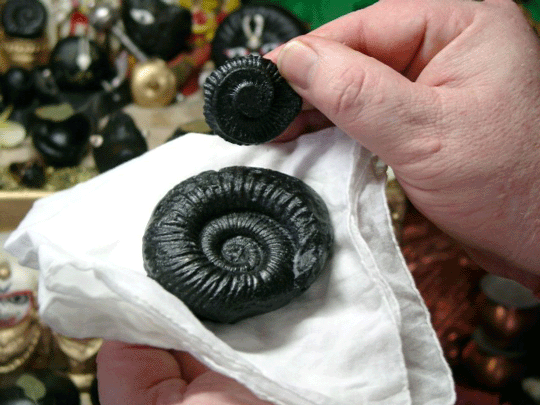
Sarva-kaama-kurma

 Srila
A.C. Bhaktivedanta Swami Prabhupada's words
of encouragement:
Srila
A.C. Bhaktivedanta Swami Prabhupada's words
of encouragement:
(These words are so to the point and so instructive that I have to
leave them here for this newsletter to. In fact I can't share them or tell
enough people of the simple genius of these words. Mutual appreciation
and equilateral acceptance of service for Krishna. It truly makes a "house
in which the whole world can live peacefully.")
excerpt from our other newsletter http://www.hknet.org.nz/Newsletter153.html
prishthe bhramyad amanda-mandara-giri-gravarga-kanduryanan
nidraloh kamathaakrter bhagavatah shvasanilah
paantu vah
yat-samskara-kalanuvartana-vashad vela-nibhenaabhasam
yatayatam atandritam jala-nidher nadyapi vishramyati
When the Supreme Personality of Godhead appeared
as Lord Kürma, a tortoise, His back was scratched by the sharp-edged
stones lying on massive, whirling Mount Mandara, and this scratching made
the Lord sleepy. May you all be protected by the winds caused by the Lord's
breathing in this sleepy condition. Ever since that time, even up to the
present day, the ocean tides have imitated the Lord's inhalation and exhalation
by piously coming in and going out. (Srimad Bhagavatam 12:13:2.)
PURPORT
At times we alleviate an itching sensation
by blowing upon it. Similarly, Shrila Bhaktisiddhänta Sarasvaté
Öhäkura explains, the breathing of the Supreme Personality of
Godhead can alleviate the itching sensation within the minds of mental
speculators, as well as the itching of the material senses of conditioned
souls engaged in sense gratification. Thus by meditating on the windy breath
of Lord Kürma—the tortoise incarnation—all categories of conditioned
souls can be relieved of the deficiencies of material existence and come
to the liberated, spiritual platform. One must simply allow the pastimes
of Lord Kürma to blow within one's heart like a favorable breeze;
then one will surely find spiritual peace.
(purport by His Divine Grace Srila A.C. Bhaktivedanta
Swami Prabhupada)
This letter is kindly borrowed from the Prabhupad Uvacha series of nectar
snippets from Srutakirti prabhu's diary. If you'd like to receive such
snippets on a daily basis please send a message to mailto:krpamaya_gauranga@hotmail.com
with the positive affirmative "Subscribe" in the Subject area.
Please Chant: Hare Krishna Hare Krishna Krishna
Krishna Hare Hare Hare Rama Hare Rama Rama Rama Hare Hare And Be Happy
If you want to introduce anyone else in reading Srila Prabhupada Nectars,
please send their eMail addresses to krpamaya_gauranga@hotmail.com








Sila Katha - Swadhyaya...
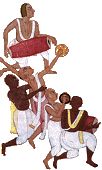
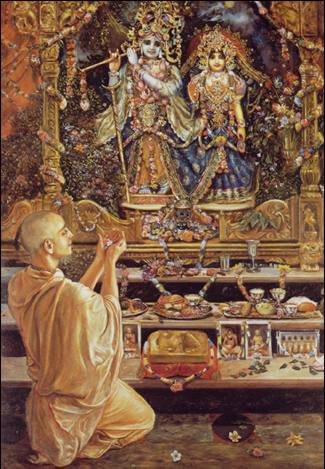

Salagram kosha
by SK Ramachandra Rao
(typed up by Kirtida Sundari - thanx)
Chapter Four
Details of Shaalagraama
page 107 - 136.
The Shalagram-stones that are worshipped are only those which are picked
up from the Himalayan stream Gandaki. The expression Shaalagraama, which
is of the Puranic celebrity, refers to a particular site in the course
of this stream, where the sacred stones were found in profusion. The site
was once a village, which was distinguished by the Shaala-trees, or by
the one grand specimen of the species (as the story told hereafter suggests);
hence the name 'Shaala-graama'. The name of the village is spelt variously
as 'Shaala-graama' (with the initial phoneme being palatal, 'talavyaadi'),
'Shaali-graama', Saala-graama (with the initial phenome being dental, 'dantvyaadi')
and 'Shali-graama'. Of these forms 'Saala-graama' is the correct one, because
'Shala' is the proper Sanskrit word for the Himalayan tree now known as
Shorea robusta (commonly, however, called, Saala, Saakhu and Sukhuaa).
The word 'Saala' is derived from the root 'shala gatau' (meaning "to move")
(anikriti shaalas siddhyati'), and signifies any tree (which is moved by
wind 'shalati vayunaa chalatiiti'), but refers principally to the tree
mentioned above (cf. the lexicon Visva, which says 'shaalo haale nripa
matsya-prabhede sarja-paadape'). Ancient and medieval treatises on Indian
medicinal plants give the name of a group of large trees as 'shaalaadi-varga'
(dipterocarpeae), which includes not only the Shaala-trees (Shorea robusta),
but also Sarja (Vateria indica0, Garjana (Dipterocarpus alatus) and Bhimasena-karpuura
(Dryobalanops aromatica or what is commonly called Sumaatra camphor). The
Shala-trees grow in the Himalayan foothills, and prevail from Kangraa valley
to Assam.
It must, however, be mentioned that the commentary on the tantrik text,
Paaraananada-sutra, provides a different explanation for the idea of shaalagraama
and insists that 'Shaligraama' is the correct form. The expression 'Shaali'
('Shaalayah' in the plural number) according to this text, signifies lords
or masters, and the word 'graama' means a collection or group thereof (samuuha-vaachii
shabdah) Shaaligraama therefore, represents a collection of gods in one
place. Shaali-graama may otherwise mean a stone (graava) which is collected
of particles of divinity.
sanskrit
It may be mentioned that the word Shaalagraama is more popularly used
in North India, while in the Southern states, 'shaligraama' (dental) is
the form that prevails among the people. But the puranic accounts, make
a clear preference for the form 'Shaalagraama'.
There is a puranic story (Varaaha purana) which explains how the village
on the banks of the Gandaki-river got the name 'Shaala-graama'. Shaalankaayana,
son of Vishvaamaitra, was a sage of great repute. He looked for a place
to perform severe austerities to obtain a vision of the god Vishnu. He
se;ected a site on the banks of the river Gandaki. This site was distinguished
by a single Shaala-tree, 'which was large, wide-spreading, unbroken and
blossoming' , and a pleasent mountain overlooking it. The sage did penance
for some days in the open with single minded devotion, and, becoming extremely
fatigued by the severe summer sun, moved to the shade of this tree.
He sat to the east of the tree with his head turned in the western direction.
Vishnu, who had appeared on the eastern side of that tree to bless him,
was thus not seen by the sage. It was on the twelfth day of the Vaishaakha
month that the sage did behold Vishnu, under the Shala-tree.
The excited and joyous sage praised Vishnu with Vedik hymns. When Vishnu
asked him to choose some boon, the sage said, "I performed the penance
only to have a vision of your glorious form; and now I have it. I want
no other boon!" Vishnu later explained that the Shaal-tree, in the sade
of which the sage was refreshing himself, was verily his own form; and
that he would abide in it. The yonder mountain, which was extraordinary,
was also his form.
Having said so, Vishnu disappeared. And the sage went round the tree
in deep devotion, and returned to his hut, looking earnestly at the mountains.
Since that time, the village became a sacred spot, and was called 'Shaalagraama-tiirtha;
and the rock in its vicinity became 'Shaalagraama-giri.'
Vishnu Purana also speaks of the mountain on the banks of the river.
However, the sacred stones are what are found in the river, and not what
are taken out of the rock on its banks. Varaha Purana makes this clear
(SK page 110)
The particular site in the course of the river where the stones become
sacred is known as Chakra-Tirtha (chakra-tirthaavachchhinna-gandaki-nadyutpanna-shilaasu
shaalagraama-pada-vaachyaa) The sanctity of this site, however, extends
to three yojanas (24 miles) allround.
There is also a river called Chakra-nadi (now called Kagbeni), which
flows towards Gandaki and joins it at the site mentioned above. This river
is described in Garuda-purana as created by Brahma; and the great peak
to the north of the river is said to contain the presence of Vishnu. All
the stones found in the river as well as in the mountain are believed to
bear the marks of Vishnu. The entire area (including streams and the mountainside
to the north of Muktinatha) covers as many as twelve yojanas (96 miles),
according to the Puranic account. Among the Shalagram stones, some are
from the waters (jalaja) and some are from the mountainside (sthalaja).
This classification is found in Varaha purana (SK page 111).
2
Although the Shalagram stones are forms of Vishnu and thus are equally
adorable, there is an elaborate attempt to identify the individual forms.
The Shalagram stones are generally associated with Vishnu and are regarded
as representations (pratika) of Vishnu; but there are also Shalagram stones
representing some forms of Shiva, some forms of Shakti, Surya, and Ganesh.
The entire panchayatana worship, an account of which has been given, could
be carried out by having the Shalagram stones signifying the five deities.
We read in Brahmaanda purana:
The need to identify the Shalagram with reference to the deities they
represent and to ascertain their worship worthy character has resulted
in a number of manuals in Sanskrit.
Besides the accounts found in several puranas (like Brahma-vaivarta,
Agni, Padma, Garuda, Nrsimha, Skanda, Brahma and Brahmanda) there are works
like Shalagram-mahatmya included in Gautamiya-tantra, Shalagram-pariksha
in Magh-mahatmya section of the Padma purana, Puja-prayog, Haribhaktivilas
of Gopal Bhatta, Shalagramarchana-chandrika, Puja-pankaja-bhaskara, Shalagram-mimamsa
of Somanatha-vyasa, Shalagram-lakshana-panjika, Shalagram-parikshaa of
Anup-simha, Shalagram-mula-lakshana-paddhati, Shalagram-sila-parikshana-paddhati
and an entire section in the Vaishnavaidhi chapter of Sri-tattva-nidhi
of Maharaj Krishnaraj Wodeyar III of Mysore.
Most of these works provide some basis for the identification of a particular
Salagrama as representing a specific form of Visnu. And the independent
works mentioned above are in large measure found to depend upon the Puranic
accounts, which are in fact readily acknowledged; there are relevant citations
from the Puranic texts. In fact all these later works purporting to help
in the examination of Salagrama-stones are in the nature of complications
of puranic passages. But the puranic descriptions of salagrama-stones are
not always uniform. There is thus quite some uncertainty regarding the
identification of these sacred stones.
All the sacred stones called Salagramas are alike in external form,
and for an untrained and uninformed eye little difference could be indeed
be perceived among the several stones. But inspected closely, the stones
reveal characteristics differences. The marks of identification are many,
like the number, location and shape of the chakras present in them, the
colours and hues of the stones, the source of the stones, the scratches
and lines on the surface of the stone representing the ayudhas of Visnu.
The devotee needs to be acquainted with the form of the deity which Salagrama-stone
symbolizes, before he proceeds to worship it.
While there is a general belief that the salagrama-stone of whatever
form or representation is worthy of worship, and although it stands to
reason, there is a Salagrama-lore, probably dating from the middle ages,
which attaches positive and negative values to individual stones.
We have it on the authority of Padma-samhita (Kriya-pada, 32, 8-11)
that all the stones marked with Vishnu’s emblems from the river Chakra-tirtha
(viz. Gandaki) are suitable for worship, irrespective of their forms and
details; worship of these stones would not without doubt lead to a worldly
welfare and salvation.
Likewise, Vishnu-tilaka-samhita (7,500-501) says that any Salagrama,
however damaged. But with the mark of discus left intact, must be worshipped
for prosperity and emancipation. Neither the rituals of invocation and
consecration, nor those of pacification and expiation are indicated in
the worship of Salagrama-stone. Bathing the stone in milk would suffice
in case of defilement by touch etc.
While worshipping the salagrama-stone of whatever form or deity, even
if there be lapses and improprieties in the worship-rituals, they are all
readily condoned and the purpose of worship would be fulfilled. So says
Sandilya-samhita (3,40).
This view, found uniformly in the Samhitas appears to have been given
up in the later puranic manuals.
Some are said to confer benefits, and some are said to portend misfortune.
Some are prescribed for householders, some others for the ascetics, and
yet some others for strict celibates. All stones are not suitable for all
devotees: the devotees are advised what would profit them and are warned
that would harm them. It is no doubt difficult to accept the proposition
that the worship of some Salagramas will result in loss, death and catastrophe;
any worship, for that matter, must bring about only a favourable change
and accomplish the welfare of the worshipper. But the manuals that we have
do indicate that some salagrama-stones must be avoided by householders.
Ancient references, however, do not make distinctions among salagrama
stones; any Salagrama-stone is taken as a visible representation of Vishnu.
The salagrama-lore that seeks to identify the different stones and ascertain
their worship-worthiness is obviously a part of the later puranic culture.
There is also discussion in some of these manuals whether the worship
of salagrama is an obligatory rite (nitya-karma) or an optional one (kamya).
The difference between these two varieties of rites consist in the absence
of specific desires and lack of material motivations in the former, and
the role of desires and motivation in the latter. The Sandhya ritual, for
instance, is an obligatory rite: it must be performed because there is
the canonical prescription: “ahar ahas sandhyam upasita”. By performing
this ritual, one does not expect to obtain any merit which will usher in
benefits. It must be done dispassionately, without motives, and with a
sense of duty. Not performing this rite, however, will result in the sin
of omission (pratyavaya); it means a neglect of duty. On the other hand,
a sacrifice like the Jyotishtoma is prescribed to be performed only by
one who desires supreme material happiness (the canonical injunction: “svarga-kamo
jyotishtomena yajeta”); is not therefore be done by one who has no desires
in this sense; it is then not obligatory, but optional.
With regard to the worship of salagrama, there are some puranas (like
Skanda) which take such worship as an obligatory rite.
Hemadri, the medieval authority on Smrti also says..
Gotama, whose authority he quotes, prescribes expiation for one who
neglects to perform the salagrama-worship (“tad akarane prayaschittam uktavan”),
thus strengthening the argument that it belongs to the nitya-variety of
rituals. An expiatory rite is prescribed to overcome a sin that accrues
otherwise ( “papa – visnuddhyartham prayaschittam udahrtam”).
If the worship of salagrama is neglected for a day, the expiation known
as ‘brahma-krchchhra’ (sustaining ones body for twenty days by drinking
only pancha-gavya and living in a temple or in a cow-pen, contemplating
on Vishnu during the whole day, and sleeping near an icon of Vishnu in
the night). If the neglect of worship of Salagrama has been for a month,
then the expiatory rite would take the form of ‘purna-krchchhra’ (living
only by the intake of a decoction of leaves); and if the neglect has been
for a year, the prescribed rite is ‘audumbara’ (sustaining oneself by drinking
the decoction of only the leaves from the udumbara tree, ficus religiosa).
But most puranas eulogize the worship of Salagramas as capable of producing
material benefits. The Salagrama-lore is replete with indications of what
benefits are to be expected from the worship of specific salagrama-stones:
wealth, progeny, success, long life, cattle, celebrity, health and so on
(cf. “aputro labhate putram salagrama-pujanat”). This makes the worship
a “kamya” ones; optional, or conditional to the desires and expectations
one has. One who has no desires then need not worship.
However, the manuals (like Salagrama-pariksha of Anupa-simha) treat
the worship of Salagrama as both obligatory and optional (nitya-kamya),
and mention that this is the traditional view (“sa cha salagrama-puja nityetibahava,
kamyeti kechit; nityakamyeti sampradayikah”). This position is justified
by the Mimamsa maxim ‘ekasya tubhayatva samyoga-prthaktvat’.
The worship of Salagrama belongs to the pratika-type of ‘upasana’. The
expression ‘upasana’ signifies devoted attention to an object close at
hand. The essential aspect of ‘upasana’ is the mental effort: uninterrupted
flow of thoughts directed towards a single object of adoration. Pratika
is an image or symbol, which directs our attention, and monitors our thoughts
in the direction of that object. Salagrama is described as the ‘adhishthana’
or the base of upasana, Vishnu being the ‘aropya’ or projected divinity
upon it. Vishnu dwells in salagrama; salagrama is the outward image or
symbol (pratika) of Vishnu. Salagrama is itself not the form of Vishnu,
nor is it identical with the godhead. But Vishnu can be worshipped in this
stone as his visible representative. Godhead could be visualized, according
to Indian thought, in water (viz. Ritual water in kalasa), in fire (viz.
Ritual fire which is sacramental), in ones own heart, in the sun, on a
prepared seat or platform, or in an image.
Salagrama stone is a variant of the image (pratima). If images are man-made,
in accordance with the canonical injunctions, and consecrated, again in
accordance with scriptural injunctions, the salagrama-stone is self-made
(swayambhu), a self-manifest image or symbol. It has numerous marks of
identification, especially in the form of discus (chakra) which is imprinted
on it. The devotee must visualize these characteristic features and attend
to them with devotion.
3
Among the general features of a salagrama stone which
helps the identification of the form of the deity that it represents and
which helps the ascertainment of the stone’s spiritual value and benefits,
seven are regarded as important.
1) Mudra (seal, sign, impression). The Salagramas bear certain marks
or impressions which help in the identification of the forms of Vishnu.
Among the large number of ‘mudras’ that the religious texts are acquainted
with, nineteen relate to Vishnu’s image: conch, discus, mace, lotus, flute,
the Sri-vatsa gem, kaustubha, garland of forest flowers (vana-mala) and
so on.
In the case of the salagrama, the expression ‘mudra’ refers not only
to these marks or impressions (recalling the divine weapons or ornaments)
but also to the physical shapes of the salagrama stones. Of course, the
shapes that can be distinctive or characteristic of deity are but few.
The Matsya-murti salagrama will have a physical form that will recall
the fish; the Hayagriva-murti-salagrama will be like a horse’s head; the
Varaha-murti-salagrama will have a snout like protuberance; Narasimha-murti-salagrama
will have a gaping mouth with sharp teeth-like structures.
Besides such exterior and readily perceivable forms (called akrti or
rupa), the salagrama-stones will also bear characteristic marks (lanchhana)
which will help in the ascertainment of the deities that the represent.
For instance, the Hayagriva-Salagrama will have marks of rosary, lotus
and book, besides having the appearance of a horse’s head.
2) Kshetra (field, class, ground, enclosed area). In the examination
of the salagrama-stone, this detail has a three-fold significance: the
class or group the deity (murti), the colour of the stone (varna), and
the mixed characteristics. The class-concept refers to a natural affiliation
that obtains between the forms of the deities: as between the Vamana-stones
and the Achyuta-stones, between the Hayagriva-stones and the Varaha-stones,
and between the Varaha-stones and the Sridhara-stones. Such correspondence
is worked out on the basis of the Vaishnava-ideology, as explained in a
previous chapter.
As regards the colours, Salagramas occur in various colours although
most of them are shades of black and blue. All salagrama-stones are smooth
and lustrous, but colours vary. The forms of Vishnu are associated with
characteristic colours: as Kapila tawny, Vamana and Narasimha black, Damodara
and Aniruddha blue, Narayana dark blue, Achyuta and Shankarshana red, and
Ananta multi-coloured.
3) Parimana (circumference, length, breadth, measure, size etc). The
Salagramas occur in different shapes and sizes. Some sizes are said to
be suitable for worship and others not. A test that is used is to wind
a thread around the salagrama-stone that is under examination, and to see
where the openings (vaktra, vadana, randhra, vivara) in the stone lies
along this thread. If the opening in the stone is in the eighth part of
the thread that goes around the stone, the stone is of the superior order;
if in the fourth part of the thread, the stone is of average quality; and
if in the third part, the stone is to be rejected as inferior.
4) Asana (seat, base). The salagrama stones are in several shapes, as
said earlier: some are perfectly round, some oval, some triangular, some
odd-shaped. But when the stone is placed on the ground, it could be steadily
poised (sthira) or unsteady (chala). The former variety is to be
preferred, for its worship makes for the prosperity, while the worship
of the other variety may lead to the worshipper’s change of residence.
The stone may rest on its sides (parsvaka), and the worship of such a one
will generate anxiety. Or the stone may be uneven and wobble, and the worship
of this stone will cause sorrow. This account occurs in Skanda-purana.
5) Murti-bheda (deity-distinction). The salagrama-stones are classified
into three groups:
i) jalaja (water-born). The stones of this group, owing to their
contact with water and mountain, will be very smooth, and possess lustre.
They are regarded as of superior merit.
ii) Sthalaja (land-born). The stones of this group are in contact with
only mountain, and therefore are rough, and lack lustre. They are of average
merit.
iii) Matha (cell-born). These stones are fossilized ammonites which
are said to be ‘eaten out by insects’, (kitaka). These are of inferior
value. They are gain in two subgroups:
a) matha-proper, when the stones are eaten out hastily by insects,
and without relish; these stones said to be devoid of juices. The Salagramas
of this type have chakras, which are very rough.
b) kesara, when stones are eaten out gently and slowly by the insects,
which also enjoy the juices which are present in the stone. The chakras
which are produced by the insects will be distinguished by numerous filaments
(kesara).
6) Sthula-sukshma-sila (the size being large or small). The salagrama-stones
occur in a large number of sizes, ranging from extremely small, less than
the size of a small marble, to a fair-sized rock. The texts, however, say
that a small-sized salagrama stone (the size of an Amalaki or emblica-fruit)
is most meritorious; large stones are not to be worshipped by householders.
The small stones bring about the fulfillment of all three values in like
(dharma, artha and kama).
7) Chakra-lakshana (characteristics of the spiral marks known as chakras).
This detail includes not only the discus marks, but all other marks on
the stone resembling the weapons and ornaments of Vishnu. In fact, the
manuals of Salagrama-examination mainly deal with these characteristic
marks. Some Salagramas resemble in shape a conch; some have linga-marks
on them, some are shaped like tortoise, some like a boar, some like a fish.
These are in fact identified as the forms of Vishnu, based on the characteristic
marks which they have. Considered by the characteristics, the Matsya-salagrama
gives long life and prosperity, the Kurma-salagrama provides progeny and
wealth, Varaha-salagrama secures suzerainty, Vamana-salagrama burns up
all sins, and Narasimha-salagrama wards off fears and anxieties. These
characteristic marks are formed of lines, scratches or spots.
4
In general, the salagrama-stones are to be properly examined before they
are taken for worship. The details to be examined are the shape and the
colour of the stone, the number and location of chakra-marks, the type
of filaments that are present in the crevices and fissures and the deity-identity.
Of the large number of deity-specific salagrama-stones, three are held
especially sacred: Vishnu-salagrama (identified by the chakra in the shape
of a garland, and by the marks of conch, mace and lotus), Lakshmi-narasimha-salagrama
(having two chakras on the left side of the opening or vadana, and dots
and specks all over the body), Matsya-murti-salagrama (fish shaped flat
stone with a single opening and two chakras, one of them inside the opening
and the other outside; having dots and specks on the body resembling a
foot-print). A salagrama with no openings but having two chakras on the
surface is usually considered ‘ferocious’ (ugra), and is either avoided
or worshipped especially elaborately. The Matsya-murti-salagrama is particularly
recommended when it has a chakra on the tail portion (viz. Rear).
There are some curious Salagramas. The Jvala-narasimha-salagrama shows
flames, when held against the light. The Ratna-garbha-salagrama is translucent
but assumes bright blue colour when seen in the sun. it is believed that
one can recognize the forms of the ten incarnatory forms (dasavartar) in
this stone, on the respective ‘jayanti’ days. The Lajavarta-salagrama acquires
an ochre colour when held to the sun. the Dakshina-murti-salagrama has
the shape of a conch, but is black in colour. The Hiranya-garbha-salagrama
is round at its rear portion and has two small dots which shine like gold.
The Vasudeva-murti-salagrama in its chakra-dhara variety exudes water-drops
constantly; it has a hollow portion for the opening (vadana), having a
pair of chakras on top as well as the bottom, the two pairs being exact
copies of each other.
The popular belief is that smooth, small and dark coloured Salagramas
are to be preferred to the rough-surfaced, large and multiple coloured
ones. There are, however, textual variations with regard to the acceptability
of a salagrama. One of the texts, for instance says…
Skanda-purana tells us that a smooth and shining salagrama is
to be worshipped by one who wishes to accomplish a mantra (mantra-siddhi),
a black one by one who wants celebrity (yasas), a pale coloured stone by
one who desires freedom from sins (papa-hara), a yellow stone by one who
desires progeny (santana), and a stone which is blue in colour by one who
aspires for worldly prosperity (abhyudaya). The stones which are red in
colour will only cause illness when worshipped; worshipping a rough stone
will result in anxiety; the salagrama with a single opening may end up
in poverty for its worshipper; worshipping a very large salagrama
will cut down the span of life (ayurhani). The tawny-coloured stones, stones
with variegated colour (karbura), broken ones, stones having many chakras
are to be avoided.
Another text recommends a moderate-sized salagrama, neither too small
nor too large.
It is prescribed that when one worships a salagrama, he must contemplate
upon the iconographic form of that deity which the stone represents, while
placing his hand on the sacred stone.
The Vaikhanasa-samhita provides a fairly elaborate account of characteristics
in a salagrama-stone which make it acceptable or otherwise. The text also
indicates the benefits which one may expect by worshipping the salagrama
of a particular type.
About the mudras, we have the following account…
What follows is the excerpt from Prayoga-parijata, regarding the colours
of the stones and their effects…
We have a slightly different version in Padma-purana….
Padma-purana has the following verses concerning the location of chakras,
shape of the openings and asanas…
The following verses taken from Agni-purana tell us about the other
characteristics of the stones (like size, shape and colour).
Narasimha-purana indicates that a stone shaped like an umbrella will,
when worshipped, cause sovereignty, a circular stone will bring great wealth;
the flat stone will produce great sorrow, while the stone shaped like a
spear will cause certain death; if the stone has an elongated spout, poverty
is indicated; if there are yellow spots like eyes, loss; if the chakras
are overlapping, disease will result; and if the opening is yawning wide,
death.
5
It was mentioned earlier that in the Vaishnava
tradition, the worship of the Dvararvati-stone (obtained from the
Gomati river in Dvaraka) along with the salagrama-stone is considered meritorious,
for the latter variety of stones are special forms assumed by Krishna himself.
However, the worship of the Dvaravati-sila is not as widespread as the
Salagrama-sila, nor has it ever had a popular appeal. It appears that its
celebrity is confined to the Vaishnava cults in Saurashtra, Bengal and
Maharashtra; the Madhva sect in Karnataka has accorded some importance
to it. The Dvaravati-stone is not as frequently seen as the salagrama-stones
in temples or households. These stones are white in colour (the hue-variations),
small in size and have markings on them resembling the chakra (in a rather
distant way). The openings in them are not characteristic features, and
are not important even when they are found. We read in several Vaishnava
texts that the worship of these stones must be conjoined with that of the
Salagramas.
The chakra-mark is the most distinguishing feature of the Dvarvati stones,
and hence they are called ‘chakrankita-sila’.
The Skanda-purana has this eulogy…
According to Garuda-purana, there are twelve varieties of this stone,
owing to the number of chakras, colours and forms (‘dasadha cha prabhinnas
ta varnakrti-vibhedatah’). When there is only one chakra, the stone is
called Devesa; when there are two chakras, it is Sudarshana; three chakras
represent the deity Ananta. When there are four chakras, the stone is Janardana.
Vasudeva is represented by the stone having five chakras, Pradyumna by
six chakras, Bala-bhadra by seven, Purushottama by eight, Nava-vyuha by
nine, Dasavatara by ten, Aniruddha by eleven and Dvadastma by twelve. Nava-vyuha
represents the collection of nine forms of Vishnu: Vasudeva, Samkarshana,
Pradyumna, Aniruddha, Narayana, Hayagriva, Vishnu, Nrsimha and Varaha.
The first four forms are well known as ‘chatur-vyuha’. The twelve major
forms of Vishnu are derived from these nine forms, according to the Tantra-siddhanta
division of Pancharatra.
The twelve forms of Vishnu are called ‘vyuhantara’: Kesava, Narayana,
Madhava, Govinda, Vishnu, Madhusudana, Trivikrama, Vamana, Sridhara, Hrshikesa,
Padmanabha and Damodara.
The Dasavatara-murti is the collective representation of the ten incarnatory
forms, which are also called ‘prahurbhava-gana’ (matsya, kurma etc).
The text also indicates the specific rewards for worshipping each of
these twelve varieties of Dvaravati-silas: 1) and 2) salvation; 3) freedom
from the fear of births and deaths 4) fulfillment of desires; 5) obtainment
of prosperity and elimination of enemies; 6) wealth and lustre; 7) continuation
of progeny and celebrity; 8) satisfaction of all that one aspires for;
9) rewards which are difficult even for the gods to obtain; 10) sovereignty
and prosperity; 11) lordship; and 12) final emancipation. The stones having
more chakras fulfill whatever one longs for, when worshipped.
Prahlada-samhita, quoted in Salagrama-pariksha (by Anupasimha) gives
the first few names differently. The Dvaravati-sila with only one chakra
is called Sudarsana, with two chakras Lakshmi-narayana and with three Trivikrama.
The rest of the names are the same as given above. The name Ananta is given
to stones have more than twelve chakras. The name for Dasavatara in the
above list is given here as Dasamurti.
When the chakras are more than twelve, only even numbered chakras are
to be preferred, according to Galava-smrtir.
The Dvaravati-sila also occurs in different colours, but white stones
are considered most suitable for worship. The dark (blue-black) stones
forebode death, the tawny ones cause anxiety, the multi-coloured ones bring
about disease and sorrow, the yellow ones take away wealth, the smoke coloured
ones produce loss of wealth, and the blue stones will bring about obstacles
to any undertaking. Only the white coloured stones will make for a worldly
prosperity in all aspects and spiritual welfare (Skanda-purana).
Garuda-purana gives a slightly different account, but white is the preferred
colour.
According to Galava-smrti, the Dvaravati-stones are auspicious if they
are round in shape or square; but not so if they are triangular or uneven
in shape. The stone which is split or broken must not be worshipped, nor
the stone which is crescent in shape. Such stones when worshipped do not
bring any rewards.
As in the case of prohibited Salagramas, the Dvaravati-stones also have
ill-effects, when improperly selected and thoughtlessly worshipped. A crooked
stone will kill the progeny, a broken one will ruin any undertaking; the
stone with many fissures or holes will produce poverty and misery. The
triangular, uneven shaped and crescent-shaped stones must not be worshipped
(Garuda-purana).
6
The texts also give us detailed information about what salagrama stones
are to be avoided (varjya, agrahya). According to Brahmanda purana, the
stones which have chakra-markings across (tiryak-chakra), which have ‘bound’
chakras (baddha-chakras, meaning thereby the chakra markings showing constraint),
which are deformed (kurupa), which have rough openings (nishthurasya),
which have a terrific aspect (karala), which look ferocious (vikarala),
which are tawny-coloured (kapila), which have uneven spirals (vishamavarta),
which have openings too wide (vyalasya), which are hollow inside (kotara),
which do not stand steadily (asana chalana), which are broken (bhanga),
which are very large (maha-sthula), which have a crevice in the bottom
joined with a single chakra (asane sushiram yasyas chakrenaikena samyuta),
which are cracked (dardara), which have a large number of chakras (bahu-chakra);
which has chakras that are broken (bhagna-chakra), which has an opening
below (adhomukhi), which has a hole or fissure (sa-chhidra), which is very
red in colour (su-rakta), which has a wide, spreading chakra (brhacchakra),
which is criss-crossed by numerous lines (bahu-rekha-samyukta), which is
an elongated chakra (dirgha-chakra), which has chakras in a row (pankti-chakra),
which has been put in a fire (pradagdhika), which has no mark whatsoever
(achihna), which has fang-like projections (krura-damshtra-samayukta) or
which has swellings like water-bubbles (sphota-budbuda-samyuta).
The salagrama stone which is unpleasant in appearance, crooked, unattractive
and repulsive, or always moist, is not suitable for worship. The salagrama-stone
which is rough and crude is likewise unsuitable. If the sandal paste applied
on the stone quickly dries up, that stone will not bring luck to its worshipper.
The salagrama-stone must be cool, and not warm.
As said earlier, the salagrama-stone which has an opening at the one-fourth
point of the circumference of the stone, when a tread is wound round it,
is a good one, and it assures fortune. If the location of the opening is
beyond this length, then the stone is not suitable for worship. The stone
which has an opening in the one-third part of the circumference is terrible
in effect.
The above prescription is sometimes interpreted as referring to the
width of the opening itself; if the opening is wide in excess of the one-fourth
part of the thread, it is described as ‘gaping’ or ‘yawning wide’ (karala).
If, however the opening is narrow, enveloped or covered, with a large hollow
inside, that stone is also unsuitable.
A large salagrama is by definition eight finger-breadths (of the worshipper)
in width; larger than that is recognized as ‘very large’ and is regarded
as unsuitable for a householder to worship.
Another text prohibits the worship of a salagrama-stone which has an
opening underneath, a chakra at the base, or an opening on top; the stone
having a chakra which extends horizontally is likewise to be avoided,
for its worship will cause ceaseless wandering for the worshipper.
The salagrama stone selected for worship must not be too small or too
large, not too emaciated or too corpulent; it must not have very minute
chakras, nor very large ones. We read in Skanda-purana several restrictions:
rough, crude, very black, gaping wide, crooked spout, distorted chakra,
a chakra within a chakra (chhakra-chakraka), rough chakra, chakras in a
row, burst within, depression on top, containing water within, wobbling,
holes at the base, swellings, and colours like ashy gray, bright red, tawny,
soiled and honey-brown.
But it must be noted that all the restrictions mentioned
above are relevant only for those who worship the salagrama-stones with
specific desires in mind (Kamya), but for those who worship without motives
and as duty of the ‘nitya’ kind, all Salagramas are worship-worthy, regardless
of all the restrictions mentioned above.
The textual prescriptions include the types and numbers of Salagrama-stones
that may be worshipped by the householders of the four ‘varna’ groupings
and by the ascetics. Puja-prakasa suggests that the Vasudeva-murti-salagrama
is suitable for the brahmanas, Samkarshana-salagrama for the kshatriyas,
the Pradyumna-salagrama for the vaishyas and the Aniruddha-salagrama for
the Sudras. Vishnu-dharmottara has the same prescription, and adds that
the brahmanas may worship four salagrama-stones, the kshatriyas three,
the vaishyas two, and the shudras one.
Similar prescription occurs in Brahmanda-purana…..
It is obvious from the above that the basic typology of the Salagramas
is in accordance with the ‘chaturvyuha’ ideology. All the innumerable deity-specific
Salagramas branch out initially from the four vyuha-deities: Vasudeva,
Samkarshana, Pradyumna and Aniruddha; and these four originate from the
‘Para’ aspect of Godhead. All the known and possible divisions of mankind
are ultimately grouped in the four ‘varnas’; and they in turn ramify from
one Purusha.
However, authorities like Vrddha-gautama indicate that brahmanas may
worship five Salagramas, kshatriyas eight, vaishyas seven and shudras seven;
for ascetics four Salagramas are suggested.
1) For brahmanas: i) Lakshmi-narayana; ii) Ananta, iii) Hiranya garbha;
iv) Purushottama; and v) Chaturbhuja.
2) For kshatriyas: i) Lakshmi-narayana; ii) Ananta; iii) Krishna; iv)
Aniruddha; v) Garuda-dhvaja; vi) Gopala; vii) Rama; and viii) Sridhara.
3) For vaishyas: i) Lakshmi-narayana; ii) Vasudeva; iii) Pradhyumna;
iv) Damodara; v) Pitambara; vi) Hari; and vii) Gadadhara.
4) For shudras: i) Lakshmi-narayana; ii) Madhava; iii) Krishna; iv)
Achyuta; v) Aniruddha; vi) Kesava; vii) Pitambara.
5) For ascetics: i) Nrsimha; ii) Hayagriva; iii) Mukunda; and iv) Maha-nila.
Thus Ends Chapter Four:
Chapter One - What are Salagrams 1-26.
Chapter Three - Vishnu and His Forms
Chapter Four - Details of Shaalagraama page 107 - 136.
Chapter Five - Identification of Shaalagraama
pages 137 - 174.
REF:
Salagram Kosha - SK Ramachandra Rao. 1996. Kalpatharu Research
Academy, Bangalore India.


Sri Shaligrama mahima
HARI SARVOTHAMA!! VAYOO
JEVOTHAMA!!
~~~~~~~~~~~~~~~~~ ~~~~~~~~~~~~~~~~~
MOOLA RAMO VIJAYATHE!!
GURURAJO VIJAYATHE!!
~~~~~~~~~~~~~~~~~~~~~~
~~~~~~~~~~~~~~~~~~~~
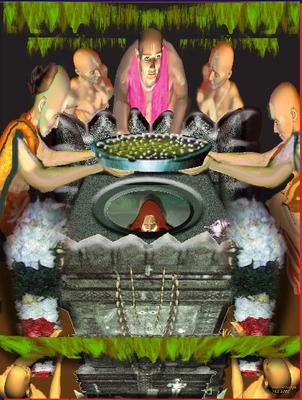
OM SRI RAGHAVENDRAYA NAMAHA!
****************************
The above picture dipicts the event of Raghavendra Swami being placed
into samdhi whilst still alive, along with his beloved Shaligrams
Something about Sripad Raghavendra Swami http://www.hindu-religion.net/showflat/cat/hinduism/112/19/collapsed/4/o/1
The Official Raghavendra Swami Mutt
site at Mantralayam
The un-official site
Message: 2
Date: Thu, 17 Feb 2005 13:14:40 +0530
From: "Sateesh" <sateeshg@hotmail.com>
Subject: FW: [IGR]: Shaligrama Mahima In English Part 1
TRANSLATED BY: SUSILA
http://www.salagram.net/sstp-shaligrama-mahima.html
More Articles like this HERE:
http://www.salagram.net/sstp-ARTICLES.html


 Salagram seva in the Sri Vaishnava tradition of
South India
Salagram seva in the Sri Vaishnava tradition of
South India
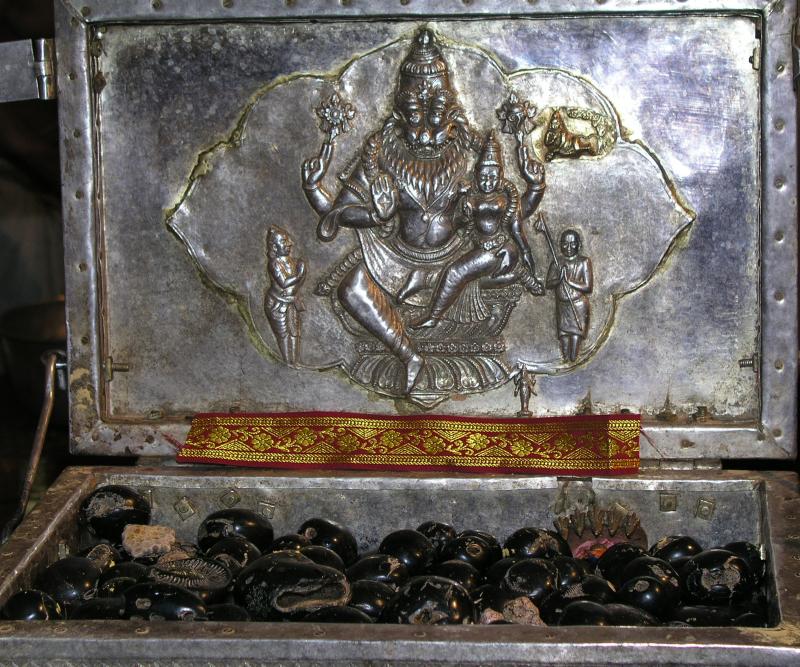
SaaLagrAmam Moorthys from the Ahobila Matam's Silver
Mantapam
It's a page with three links, with info about questions about salagrama
aradhana in the Sri Vaishnava tradition,
and a very long pdf file on the laghu aradhana kramam (with devnagri
and tamil verses, so it's meant for a certain audience).
Please Click HERE
to enter their page
Sri Vaishnava perspective o Salagrams
http://www.sadagopan.org/sg/sgmain.htm


Hari Prasad Kemka - Varanasi (Banares - Kasi)
and his 65,000 Silas
Here is a heavy sadhu in Varanasi named Hari Prasad Kemka. He is working
65,000 shaligram with his devoted wife. Below she is reading before the
deities a book only with the Hare Krsna maha mantra written in it. Daily
100 liters of water are poured over Their Lordships and some of the caranamrta
is poured over the two tulasi plants gardens outside this altar room.
10 workers are used daily to grow and trim tulasi for the daily 6 inch
tulasi blanket of that covers the Lords. Any guests who come will be served
a liter stainless steel glass of either of milk or yogurt, according to
personal preference.
Not any ordinary gardener??? When I arrived I showed my beautiful Hayagriva
sila with wavelike chakras, that was hanging around my neck and Hari Prasad
took him from me and to my amazement placed him on the top of the subji
in a big bowl at the present offering. When Hayagriva had finished the
meal along with the Rest, He was given back to me and He was quite warm
for some reason(smile). We noted later on how the subji had some mean chilis
in it also.
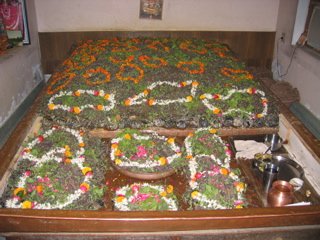

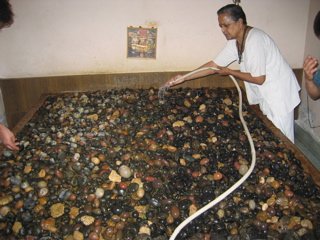
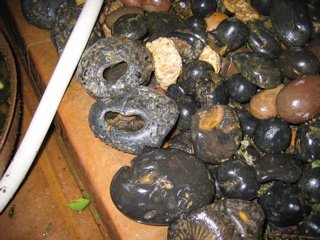
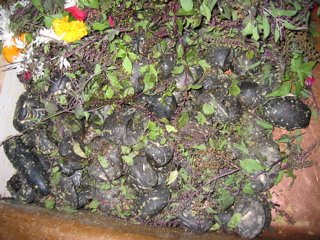
So the Shaligrams were obtained by both helicopter visits to Damodhara
Kunda and purchases in the market places. When discussing this, that it
was an offense to buy or sell, his reply was this" Well true it may be
a great offence to buy, but I had to obtain my Lords somehow or other because
all my life I wanted to worship Sri Shaligram in a grand way and if I go
to hell so be it I don't care, I am always with my Lord...my Lord will
have to come to hell with me!"
There was this one devotee from Argentina, Lilamadhava (second row far
right with long loose hair), who wanted to get up to 108 shaligrams for
his puja. He begged from Hari Prasad for some silas. Hari was very firm..."No
no no" over and over again. "I have not given one sila away for over 25
years". But Lilamadhava kept persisting him saying "Don't you realize
if you give sila then more will come...just one out of your 65,000 (by
the way 5000 of the silas are Shiva lingams).."Again Hari said no. I was
amazed at the persistence of this boy. I would never push another in this
way, knowing full well I don't like others trying to extract silas from
my care...Hari Prasad said "If my God speaks to me then I will give...right
now He is not telling me anything. Lilamadhava said "Ok I will come back
to night after you return from work and then let us discuss further".
You may note that in this picture there are many red silas and
sadly enough Hari Prasad's 30 year old son who was going to take over the
sila worship died 6 months ago...Hari Prasad and his wife were getting
older.
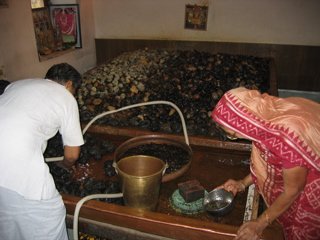
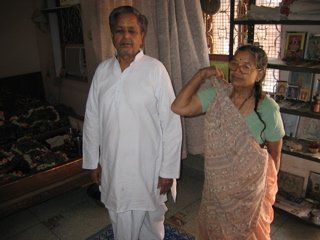
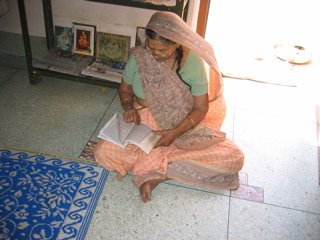
When the boys returned that evening they met Hari Prasad with tears
in his eyes, saying "My Lord has spoken" and he began to give silas freely
to all who were present. With tears in his eyes he said " I have never
done this before". He said looking at Lilamadhava" If you build a temple
here in Varanasi, I will give all of them to your care and keep only a
few for my personal seva". Whoa!!!
Amazing... so now Lilamadhava is planning to build a house in
Varanasi and serve These Lords in grand way....but these Lords will be
worshipped in ISKCON. This man is a true sadhu and his promise is equal
to his devotion. All glories to the Sri Krsna Sankirtan!
A further note that during our Ganga Safari 2005 led by HH Jayapataka
Swami from Ekachakra to Ramakeli, Varanasi, Ayodhaya, Prayag, Allabhad
and Rishikesh, many Sila Lords manifested to hungary sevaks. Who knows
what may happen on future visits? The Lord seems to be making a special
appearance in the present times.
Article written by Bhaktisiddhanta swami
JPS
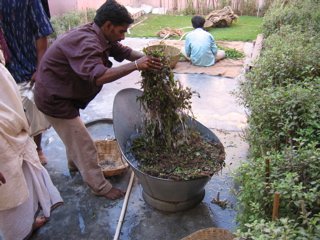
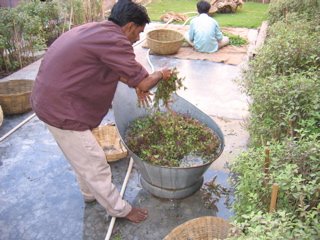
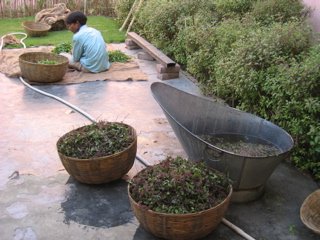
Tulasi that is offered daily
Hari Prasad prabhu's page is listed as http://www.salagram.net/sstp-HariPrasadKemka.html

Identification of Salagramas
from Sri Tattwa Nidhi kosha
http://www.salagram.net/sstp-Sri-tattva-nidhi-kosha.html
The following account is taken from Sri-tattva-nidhi,
an encyclopedia work in Sanskrit compiled by the late Maharaja of Mysore,
Krishnaraja-wodeyar III (1780-1865). This monumental work in nine sections
(which are called ‘treasures’, ‘nidhis’) is profusely illustrated by miniature
paintings, and deals with the iconographical lore, subjects like Agama,
Jyotisha, Sangita, and games and pastimes. The work, not yet seen in print,
is in the nature of a compilation from hundreds of ancient and medieval
manuals and texts. In the Vaishnava-nidhi section of this work, is the
account on salagrama-stones as anionic emblems (symbols) of Vishnu, which
is reproduced below, with a running translation in English.
The authors of this work has preferred the expression
(dental) ‘saligrama’, which is also the more popularly used form in South
India as well as North India, to the more correct ‘salagrama (palatal).
And the account of these sacred stones has been taken from Narasimha-purana
(Brahma-Narada-samvada). It may be seen that the account given in Sri-tattva-nidhi
is rather haphazard and ill-organized, as compared with, for instance,
the Salagrama-pariksha of Anupa-simha, who was the Maharaja of Bikaner.
The text of the relevant and corresponding portions of Salagrama-pariksha
have been given in the Appendix. This text, in contrast, is well-organized
in three distinct sections (1) murtis relating to the ten avataras; (2)
murtis relating to the twenty four forms (chatur-vimsati murti); and (3)
miscellaneous forms (prakirna). Although all these forms are dealt with
in Sri-tattva-nidhi, the descriptions are confined to those given in Narasimha-purana,
whereas Salagrama-pariksha provides information from other puranas also.
Not only the order of deity-specific salagramas given
here is haphazard, but some of these forms are repeated during the course
of narration more than once, with different descriptions. While the major
part of the text is taken from Narasimha-purana it is likely that passages
have also been incorporated. The text, however, is unsatisfactory, especially
when compared with words like that of Anupa-simha. But the matter here
represents the South Indian tradition with regard to the Salagrama-lore.
(Narada tells Brahma that he was enlightened by the letter
on many topics, and requests him that he be pleased to tell him about the
other Salagrama-stones; about their origin, characteristics like colour
and field, the differentiation in respect of divine form, and their suitability
for purposes of worship.)
(Brahma proceeds to tell Narada about the salagrama-stones:
their origin, identification, colour, field and other details.)
There is in the country of Avanti, a sacred mountain
around which is the site which is the source of all the salagrama-stones.
Merely to remind oneself of this sacred site is to get
rid of all the sins that have accumulated in the past. It is here that
the river Gandaki, which destroys all sins, flows. By a touch of the waters
of this river, one obtains residence in the realm of Vishnu. At the foot
of the mountain in this site is a great stream known as Chakra-tirtha.
The source of that river is said to be Vishnu himself; and in that mountain-stream,
the god who wields the discus dwells. He abides here along with his consorts
Lakshmi and Bhu, and in every stone that occurs in this sacred site. In
the bowels of the rocks free from wind and cold the salagrama-stones are
formed, with all adorable characteristics. On auspicious moments, these
sacred stones get formed by the grace of God. The formation of spiral marks,
the chakras, in these stones is explained as follows:
After thousands of years, the animal called vajra-kita
(the adamentine worm) was born in these stones; the animal was in fact
the form which Vishnu himself assumed.
Having entered into the bowels of these stones, the animal,
golden coloured, mighty and brilliant like a flash of lightning, making
a sweet noise, carves out the marks of discus of numerous kinds and various
other marks with ease in the stones. The animal, who is Vishnu himself,
the lord of Lakshmi, resides inside these stones for countless years; the
presence of Godhead is unbroken here.
By a mere look at these stones, all the sins that one
had accumulated will at once get destroyed.
The variety of forms, colours and other characteristics
of the salagrama-stones.
The sacred stones may be white, yellow, red, black, green,
tawny or ash-coloured; they may contain stains, and they may be multi-coloured.
The colours might be excessive or faded; the colours
may otherwise be difficult to determine. The stones occur thus in many
colours and forms.
The salagrama-stone is described as the ‘field’ for the
presence of Godhead. The differentiations in this regard are dependent
on the colours. The Vasudeva-salagrama is white in hue; the Hiranya-garbha-salagrama
is yellow; the Pradyumna-salagrama is red. Vishnu-salagrama is black
stone; Narayana-salagrama is greenish in colour; Narasimha-salagrama is
red; and Vamana-salagrama is like the atasi flower in colour (flax, Linum
usitatissimum)
The colours have their own effects and influences.
The ash-coloured salagrama stone is especially suitable
for worship by ascetics. The stones which are stained bring decay and destruction,
the multi-coloured stones are also unfit for worship, unless it be Ananta-salagrama.
Highly coloured stones cause misery; the faded colours
destroy the lineage; the colours which are indistinct and uncertain make
for death.
The tawny-coloured stone is consort-killer; the bluish-stone
brings wealth; the black-stones cause nourishment and prosperity; and the
red-stone brings in sovereignty.
Excessively red-stone, however, deals death; the fair-coloured
stone (viz. White) bestows wealth; multi-coloured stone makes for prosperity,
while the faded colours are not useful when worshipped.
There is some confusion here with regard to the expression
‘bahu-varna’.
White coloured stones facilitate the obtainment of emancipation,
and the stone with indistinct and uncertain colours destroy everything.
The salagrama stones differ with regard to their circumference
(parimana), which is measured in terms of the size of the aperture.
The wise one will tie round the middle of the salagrama-stone
a thread; and if the aperture is located at the spot which marks one-eight
of the thread’s length, then the stone is of superior variety; it may also
be of the middling variety. However, the stone having an opening in the
one-third part is to be rejected. (However, Brahmanda-purana has a different
prescription: There are different effects in terms of locations of operators.
If the aperture is downward, it is terrible; the aperture on top will be
useful only in magical rites of driving away the enemy; The apertures being
even are especially meritorious, while the aperture on the sides will take
away fortune.
If the aperture is crooked, it causes disease; if long-mouthed
it devours everything (viz. Makes one impoverished). One should carefully
examine the stone before ascertaining the deity-specification.
The manes of the ten incarnatory forms of Vishnu:
The forms of Vishnu are: Matsya, Kurma, Narasimha, Rama
(son of Jamadagni; viz. Parasu-rama), Rama (viz. Bala-rama), Rama (son
of Dasaratha), Buddha and Kalki.
The characteristics of the salagrama-stones, which are
deity specific:
The Matsya-murti-salagrama has the form like the head
of the fish; a chakra is seen on the face; there are also marks of sri-vatsa,
dots and scratches resembling vanamala (garland of wild-flowers)
The Maha-kurma-murti-salagrama is round, shaped like a
tortoise, and has marks of vanamala, lotus and discus; its colour is green
(viz. Of tree Butea ftrondosa); and it has golden spots.
The Varaha-murti-salagrama is long-mouthed, is blue-black
in colour, has an encircling mark of earth, and is distinguished by a shining
chakra at the opening.
The Buddha-murti-salagrama has two apertures, and two
chakras in the interior. The chakras are upward-inclined at the head, or
they are at the sides. The stone may be multi-coloured.
The Narasimha-salagrama has an elongated mouth, tawny-hued,
a longish chakra and a big belly (viz. Middle portion). This stone is suitable
for worship by ascetics.
The Lakshmi-Narasimha-salagrama has a chakra on its left
side, is black in colour and has spots (viz. Dots). Its worship makes for
worldly prosperity as well as emancipation.
The Vamana-murti-salagrama is shining blue in hue; it
is small in size and perfectly round in shape; it has marks of vana-mala
and lotus.
The Parasu-rama-murti-salagrama is distinguished by the
line-scratches resembling an axe; it is dark blue-green like the blade
of the durva-grass; it is high in stature and is adorned with a chakra
at its navel.
The Sri-rama-murti-salagrama is large, elongated and has
spots on its body; there are also line-markings resembling bow and arrow;
there is a chakra at the navel, and dark stone has many fissures.
The Bala-rama-murti-salagrama has marks of the plough-share,
and of the pestle-like weapon on it; it is whitish in colour, and has line-scratches
of vana-mala; there are also dots like honey drops. This is the abode of
Samkarshana.
The Srighana-murti-salagrama is white in colour and exceedingly
smooth to touch. It has a thousand (viz. Many) spots on the surface, and
also a chakra.
The Kalki-murti-salagrama is recognized by the line-markings
resembling a horse, and the weapon called Kunta (lance). It is white in
colour, and has a long mouth.
The Sri-krishna-murti-salagrama has markings of the five
weapons (conch called Panchajanya, discus called Sudarsana, mace called
Kaumodaki, bow called Sarnga, and sword called Nandaka), vana-mala and
lotus; is has a minute chakra.
The Sri-gopala-murti-salagrama has the markings of the
five holy weapons (mentioned above); it has no apertures; it is either
round in shape or elongated; a vana-mala mark is seen on it.
This salagrama can have identification marks of a single
deity or of a combination. It may be longish in shape, and is characterized
by a big belly (viz. Middle portion being big); it has scratches resembling
flute-openings.
The Dadhi-vamana-murti-salagrama has a downward chakra
at the top which are spots like honey drops, the stone has a bluish tinge
as well as reddish hue.
The Dadhi-gopala-vamana-salagrama has a chakra on top,
with spots like honey-drops at its upper end.
The Santana-gopala-murti-salagrama has marks of cudgel
and horn (which cowherds carry) on its sides, and at the head position
can be seen the mark of a flute. The worship of this stone ensures progeny.
This stone is blue in colour and elongated in shape;
it has an aperture which resembles the elephant-goad, a chakra.
The Pradyumna-murti-salagrama is of the colour of a hibiscus
flower (viz. Red) and is marked by lines and scratches resembling vana-mala,
bow, arrow and lotus. Its worship bestows whatever one longs for.
The Aniruddha-murti-salagrama has the same characteristics
as the above (viz. Pradyumna murti), but is recognized be an aperture with
a minute chakra, and by marks of golden and silver lines.
The Hayagriva-murti-salagrama has the form of a ripe jambu-fruit
(rose apple, Eugenia Jambolana), with a face in the shape of an elephant
god; it has also longish spots on its body.
The Sridhari-murti-salagrama shines like fresh green grass,
has uneven chakras and there are marks on it resembling vana-mala.
The Lakshmi-narayana-murti-salagrama has a low or depressed
look, and is perfectly round, and cold to touch; it has a chakra on its
head; there are two apertures and there are four chakras either to the
left or to the right.
The Padmanabha-murti-salagrama has a lotus-like chakra
at its navel, and is of the colour of a rose apple (Eugenia Jambolana).
The Govinda-murti-salagrama is dark blue like the blade
of a fresh durva grass; it has ten apertures and twenty chakras; and there
are scratches on its body which look like vana-mala. The worship of this
stone secures the fulfillment of all desires.
The Visvarupa-murti-salagrama is known by its twelve apertures
and twenty four chakras. Its worship will bring about worldly prosperity
as well as final beatitude.
The Ananta-murti-salagrama is always cold to touch, but
shines like a blaze of fire; it has an even number of minute chakras, with
marks of the classical five weapons of Vishnu (conch, discus, mace, bow
and sword), and also of Sri-vatsa-mark on the chest.
The Lakshmi-narayana-murti-salagrama is hard to obtain,
and its worship quickly fulfills ones desires. At the entrance to the aperture
are lines which resemble the flying bird Garuda (the vehicle of Vishnu).
The Narayana-murti-salagrama is recognized by the shape
of the serpent’s hood that seems to surround it. Its worship secures the
fulfillment of whatever one seeks for.
The Damodara-murti-salagrama is longish in shape, and
brilliant in appearance; there are marks on its body of conch, discus,
mace and vana-mala.
The Trivikrama-murti-salagrama is longish in shape, and
brilliant in appearance; there are marks on its body of conch, discus,
mace and vanamala.
The Janardana-murti-salagrama is characterized by its
blue colour and marks of conch, discus and lotus; it is cold like
ice; and has a shape like a spear.
The Vasudeva-murti-salagrama has the appearance of tranquillity,
and shines like moon-light; it bears the marks of the five weapons of Vishnu
(conch, discus, mace, bow and sword), and has a chakra at its navel.
The Vishnu-murti-salagrama has the dark colour of the
Vishnu-kranta flower (Clitoria Ternatea or Evolvulus Alsinoides), the marks
of the five weapons of Vishnu (mentioned above), and also of vanamala and
lotus.
The Achyuta-murti-salagrama is bluish in hue and large
in size; it is smooth and has minute chakras; it has marks of vanamala
on its body.
The Upendra-murti-salagrama is also shining blue in colour,
with marks of conch, discus and mace on its body. Its worship will cause
happiness and good fortune.
The Siva-nabha-murti-salagrama is roundish like an elephant’s
body; and in the central portion thick lines are seen. It is hard to obtain,
but its worship secures all desires.
The Hiranya-garbha-murti-salagrama is blue-black in colour
and cold to touch; it has no apertures, but it contains gold within (viz.
It has spots in golden colour in the middle portion of the stone).
The Madana-gopala-salagrama is partly black in colour
and partly reddish; it has a long aperture on its left side; and there
are marks of conch, discus, bow and moon.
The Janardana-murti-salagrama shines like blue water-lily
(utpala, Nymphala caerulea); it is recognized by the vana-mala mark which
goes round the stone.
It is elsewhere described as having six apertures and
twelve chakras, slippery to touch, and marked by vana-mala.
The Lakshmi-narayana-murti-salagrama has two chakras on
top and two chakras at the bottom.
The Sriman-narayana-salagrama has two chakras on each
of its sides.
The Sudarsana-murti-salagrama is round in shape or sometimes
oval; there is a single chakra seen at the aperture; and there are spots
on the body of the stone.
Elsewhere, this is described as equipped with two chakras
at the top, and as exceedingly ferocious in aspect, and as such worthy
of worship only by ascetics.
The Vanamala-murti-salagrama is of tawny hue, and has
an aperture at the sides of which are fang-like structures and inside which
are two chakras; the aperture is crooked, and by its side is the vanamala
mark.
The Maha-jvala-nrsimha-murti-salagrama is thick in shape,
blue-black or tawny in colour, and has a gaping mouth (aperture). This
is fit for worship only by mendicants.
The Siva-nabha-murti-salagrama has a linga-like form on
top where there is also an aperture; it is perfectly round in shape and
cold to touch. It is auspicious and secures all prosperity.
The Buddha-murti-salagrama is muddy coloured and has spots
on it; the chakra is there in the aperture, but unseen; the chakra also
is dark gray in colour.
The Lakshmi-nrsimha-murti-salagrama is tawny in hue, and
inside its aperture is a large chakra within which is another chakra, minute
in size.
The Sveta-varaha-murti-salagrama has a long snout, and
one tusk; it is whitish in colour and exceedingly clear; there is but a
single mark on its body which resembles vanamala.
The Bhu-varaha-salagrama has a raised body with a head
shaped like an elephant goad; there is a chakra at the bottom, and near
it
can be seen a structure like the single tusk. It is an auspicious stone.
The Kurma-murti-salagrama is thick and compact in structure,
blue-black in colour, variegated hue, tawny or black; it has chakras.
The Hrshikesa-murti-salagrama is dark blue (or black)
in colour, soft to touch; it has five apertures and ten chakras.
The Keshava-murti-salagrama is blue black in colour with
minute chakras; it has golden and silver spots, and a mark resembling vanamala.
The Achyuta-murti-salagrama is extremely cold to touch,
and has a small aperture; it has a chakra on the surface and two chakras
within the aperture.
The Vaikuntha-murti-salagrama is blue-black in colour
and soft to touch; there are line marks of eight weapons of Vishnu, and
also a mark of vana-mala; there is an aperture like the lotus stalk.
The Vishtara-sravo-murti-salagrama is a large one, elongated
in shape and has apertures on both of its sides; there is a chakra, and
also the mark of vana-mala going round.
The Hiranya-garbha-salagrama is moon-like in appearance,
slippery to touch, and large in size, raised on top. There is a chakra
at the entrance of the aperture.
The Tri-murti-salagrama is characterized by the marks
resembling conch and discus (emblems of Vishnu), snake and battle axe (emblems
of Siva) and lotus and water-pot (emblems of Brahma), and marks of three
garlands.
The Kurma-varaha-murti-salagrama has a chakra with two
dots or the mark of conch; and there is another minute chakra nearby. This
is difficult to procure and its worship will secure the fulfillment of
all desires.
The Matsya-murti-salagrama has the shape of a fish, and
is spotted; there is the mark of shakti-linga (viz. Trinagle) at the head
which is unevenly situated or at the place where the mouth would be located.
The Varaha-murti-salagrama is dark-blue in colour thick,
and marked with three lines. Its worship promises the fulfillment of all
desires.
The Kapila-narasimha-salagrama has a large chakra at the
place where the tusk would be located; the colour of the stone is tawny,
and there can be seen on the stone the mark of vana-mala. This must be
worshipped only by celibates for worldly prosperity or for salvation.
The Vamana-murti-salagrama is of the colour of flax-flower
(Linum usitatissumum) and is endowed with spots on the top; there are scratches
resembling ear-rings; and also a spot on the head. The stone is small and
round.
The Dadhi-Vamana-murti-salagrama is a small one and perfectly
round; it is black in colour and has spots on top. There is a chakra in
close proximity to the aperture. This is hard to get, but when worshipped
it secures all desires.
There is another variety of this salagrama which is small
and has two spots; it is dark in colour and extremely greasy (or smooth);
there is on it the mark of vana-mala. It is an auspicious stone, facilitating
worldly prosperity as well as salvation.
The Lakshmi-nrsimha-murti-salagrama is black coloured
and spotted; on its left side are two chakras. The worship of this stone
secures prosperity here and liberation hereafter.
The Rama-murti-salagrama resembles in its colour the kadamba
flower (Naulea Cadamba, viz. Orange) and is spotted; there are marks on
it of bow, arrow and lotus. It is pleasant in appearance, but difficult
to obtain. Its worship is capable of fulfilling all desires.
The Sri-rama-murti-salagrama is like hen’s egg in shape,
and is blue-black in colour; the rear portion is raised; at the back are
scratches resembling a bow, the wish-fulfilling tree and royal parasol;
and criss-cross lines suggesting a quiver. This is a rare salagrama.
The Sita-rama-murti-salagrama has a shape that resembles
a hen’s egg, and has an opening at the bottom, with marks like ear-rings.
At the entrance are evenly situated chakras; and the mark of the wish-fulfilling
tree is also there. There are chakras at the front and on the left side
and line scratches.
The Gopala-murti-salagrama has the shape of a jambu-fruit
(rose apple), and is black in colour; there are also spots. At the rear
there is an aperture, and a mark of ear-rings (makara-kundalas); on the
forehead of the stone, slanting to the left are the mark of he arrow and
bow, with spots. This sacred stone is capable of eliminating enemies and
fulfilling all desires when worshipped.
One who has no progeny will procure progeny; and the
stone is all auspicious.
The Brahma-murti-salagrama (Parameshthi) is whitish in
hue, and perfectly round; it may also be yellowish. It has a single chakra
and mark of a lotus; and at the rear portion is an aperture.
The Vasudeva-murti-salagrama is small and round, very
much like an areca-nut; there are two chakras evenly located at the entrance
of the aperture. However, there are no chakras in the interior. It is rather
whitish in colour and brilliant in appearance. When worshipped, it can
help avoid untimely death; and it will secure all desires.
The Maha-vishnu-murti-salagrama is pleasant in appearance,
and the spiral mark in lines is seen on its surface. It shines brilliantly,
and is black in colour. It is an auspicious stone and will remove all fear
of death.
The Narayana-murti-salagrama is blue-black in colour,
and has a chakra at the navel, which is also raised. There is long line-marking
on its surface and the mark of vanamala in gold.
The Lakshmi-narayana-murti is of yellowish hue, and its
left side is rounded; there are four chakras surrounded by a long time.
There are markings of pestle, sword, bow, vanamala, conch, discus and mace
on the face and at the navel. The stone is suitable for all prescribed
rituals; it will cause prosperity, and accomplishment of ones desires.
The Sridhara-murti-salagrama is recognized by the prominent
marking of vanamala; the stone’s colour is very much like the Kadamba flower
(Nauclea Cadamba, viz. Orange). Its worship secures all attainments
The Samkarshana-murti-salagrama is characterized by two
chakras situated in the same spot, and by the front portion being large.
The colour of the stone is reddish, and it is beautiful to look at.
The Pradyumna-murti-salagrama is of bright yellow colour;
there is a minute chakra, and there are numerous apertures in the elongated
body of the stone.
The Vishnu-murti-salagrama is bluish in colour, round
in shape and has a chakra which is large in size. It may otherwise be blue-black
in colour. It is a beautiful salagrama.
The Krishna-murti-salagrama is recognized by a long line
in the middle, which resembles the mace. The worship of this stone helps
one to acquire worldly prosperity and also obtain emancipation.
The Kurma-murti-salagrama is raised on the rear side,
and is adorned by white hood-like structure and marked by a hoof (foot
mark of horse). It has black spots but otherwise clear. The stone is suitable
to be worshipped on all auspicious occasions.
The Ananta-murti-salagrama is distinguished by the marking
of the serpent hood. The banner-like marking is seen in the middle, accompanied
by a line. The stone is a large one, shaped like a serpent; and has seven
chakras.
Another variety of Ananta-murti has eight or ten chakras,
which indicate its superior merit. It may also have thirteen or fourteen
chakras, which enhance its value. The stone is yellowish, bluish or variegated
in colour. It has markings of discus, conch, mace, lotus and vanamala.
The worship of this stone is calculated to secure all prosperity.
The Trivikrama-salagrama is shaped like a hen’s egg; it
has a chakra on the top-position; there are two other chakras and on one
side of the stone is larger on the other. There are markings of flag, conch
and ploughshare; there are also spots. Its worship helps avoid untimely
death.
The Lakshmi-gopala-murti-salagrama is also shaped like
a hen’s egg, but has markings and ear-rings. This stone is an extremely
rare one; and its worship assures progeny, prosperity and salvation.
The Sri-hari-murti-salagrama is a large one and its colour
is that of copper (or red).
The Balabhadra-murti-salagrama, which is worshipped for
obtaining celebrity and cattle wealth is blue-black in colour and its shape
is that of a parasol; it is smooth (greasy). It is characterized by animating
opening, by a spot and by red lines. Its fore-part is bulky, and its body
is soft and shining.
The Gopala-murti-salagrama, which is a very rare one,
is worshipped for obtaining progeny, increase of cattle-wealth and emancipation.
The Lakshmi-gopala-murti-salagrama is shaped like parasol,
and is extremely unctuous: it has no apertures, but spotted. It is large,
heavily and brilliant.
The Varaha-murti-salagrama is dark in colour (blue-black),
has the rear part raised, and is adorned by a golden spot at the back.
There are two chakras evenly located; and at the bottom is a minute chakra.
The Janardana-murti-salagrama is distinguished by four
chakras.
The characteristic features of some salagramas representing
deities like Sudarsana are given below:
The Sudarsana-murti-salagrama has but a single chakra,
while the Lakshmi-narayana murti has two chakras, the Achyuta-murti three
and the Janardana-murti four. Vasudeva-murti has five chakras, while Samkarshana
has six, Varaha-murti seven, Purushottama-murti eight, Narasimha-murti
nine, Vamana-murti ten, Pradyumna-murti eleven, and Ananta-murti twelve.
The supreme spirit abides in other multi-chakra-stones also.
The especial benefits of worshipping these different varieties
of salagramas are narrated as under:
The Hiranya-garbha-salagrama brings all good fortune to
the worshipper; it is like worshipping a thousand Shiva-nabha salagramas.
It assures worldly prosperity.
There are, however, some salagramas which are difficult
to identify with specific deities.
There are many deities in a salagrama as the forms of
Vishnu are (viz. Innumerable). It would be impossible to separately identify
all the forms of deities in salagrama even in a million years.
Now then the forms of the salagramas that must be avoided
(viz. Not worshipped) are given:
The salagrama-stones which have irregular angles, which
are burst, burnt, stained, or warm to touch must be avoided, as also those
without chakras, or those which have been embrocated (rubbed and frayed),
or which have crooked apertures.
Likewise the stones with numerous chakras, crooked chakras
and chakras at the bottom, must be avoided.
The stones with many arrow-like lines, or with chakras
which cannot be deciphered at all; the stones which are shaped like unripe
bread-fruit (Artocarpus integrifolia) or like the deep-brown vegetable
(Caculus melanoleucus).
The stones which are fettered (clasped or joined) or obstructed,
the stones which have a cruel, terrible and awesome aspect, and the stones
which have crooked snouts must be avoided.
The stones which are broken or burst open, the stones
which are burnt, and the stones which are triangular in shape must be avoided,
as also those which have internally split, and damaged; and the stones
which have many scratches and fissures must also be avoided.
The effects of worshipping the salagramas which are to
be avoided, are given below:
Worshipping a broken, burnt or warm stone makes one become
impoverished; by worshipping joined stones, tangled chakras or a triangular
stone, one will witness the death of relatives.
By worshipping a stone which has suffered an internal
bursting, the worshipper’s relatives or children will die. By the worship
of stones with no markings at all, one loses his wealth. By worshipping
a stone which has a ferocious aspect, one gets great sorrow, and his family
will be destroyed.
The salagramas must, therefore, be carefully examined
with regard to their worthiness for worship.
In the salagramas abide all the fourteen realms, and therefore
when one gifts the salagramas to others, God will be pleased.
However, one must accept a salagrama which has already
been worshipped, and one must gift the salagrama after worshipping it.
Both the receiver and the donor will obtain merit. But one who sells or
buys salagramas will only be sinning.
The place where Salagramas are kept and worshipped is
pure by that very act.
There is no offence or transgression in keeping or worshipping
the salagramas which are split, burst, broken or cut open.
Elsewhere also it is said, a salagrama is still auspicious
and worthy of worship if it has a chakra (intact), even if the stone is
split, burst or broken.
The different salagramas indicated for celibates, householders
are mendicants:
The celibate and the mendicant may worship salagramas
with multiple chakras, salagramas which are muddy coloured, rude and crooked,
and which are shaped like a lion (lion’s mouth).
The mendicant should worship the salagrama stones which
have fire in the navel. The householder should worship only the salagramas
of pleasant aspect.
In a house, two lingas or two salagramas must not be worshipped,
nor should two Dvaraka-silas or two sun-stones should not be worshipped.
Three emblems of Ganesha or Devi must not be worshipped,
nor two conches. An icon that is damaged must not receive worship; likewise
ten salagramas (Matsya-murti and so on) must not be worshipped.
In a house, the salagramas that are burnt or damaged in
fire must not be worshipped, for otherwise great anxiety will be occasioned.
An even number of salagramas must be worshipped, except
when they are only two (in which case, they must not be worshipped); and
an odd number of salagramas must never be worshipped unless it is only
one salagrama (when it may be worshipped).
The merit of sipping water in which the salagramas have
been washed.
One who sips the water in which the salagrama has been
washed in the presence of Vishnu, will be freed from all sins and will
eventually enter the realm of Vishnu to abide with him.
The merit that accrues from studying this section on salagrama-characteristics
or from listening to it:
O Narada (says Brahma), thus have I explained to you
the glory of salagrama; you should comprehend this with devotion, for the
sake of pleasing Vishnu.
One who listens to this section which details the merits
of salagramas will obtain the four values of life (righteous living, wealth,
pleasures and emancipation), and he will be dear to me.
One who studies this text which extols the merits of salagrama
day and night, especially during the annual obsequies, will receive untold
benefits from whatever he offers to the ancestral spirits.
Having heard this, Narada bowed before Brahma and worshipped
him.
Narada says:
You have explained to me, O Brahman, the differentiation
of the salagrama-stones, their characteristics and deity-specifications,
as also their shapes and colours, which are meritorious or otherwise.
Brahma says:
Listen, Narada, I shall tell you about something which
you did not ask: namely, the different effects according to the different
colours of the stones.
The salagrama stones occur in many colours: black, blue,
yellow, gray, red, tawny and white: they may be ash-coloured. The stones
indeed are of numerous kinds. But they must be examined with regard to
their beneficent characteristics and only then accepted for worship.
The tawny coloured stone, when worshipped, will kill
the worshipper’s wife, while the blue-black stone will bring in wealth.
The black stone will cause nourishment and increase of wealth; the white
stones will facilitate liberation.
The yellow stone will cause affluence, and the red-coloured
one will secure sovereignty, while the intensely red stone will cause death;
the extremely black stone will reward the worshipper with celebrity; the
ash-coloured stone will cause great sorrow and produce poverty.
Now then, the differentiation of salagrama-deities in
accordance with the colours of the stones:
The tawny coloured stone represents Narasimha, the flax-coloured
stone Vamana, white-coloured stone Vasudeva and red-coloured stone Samkarshana.
Damodara is represented by the blue-coloured stone, Aniruddha
likewise, Narayana by blue-black stones, and Vishnu by black-coloured stones.
Multi-coloured stones indicate Ananta; yellow-coloured
ones Sridhara; White coloured ones Vasudeva and stones which are bright-white
in colour Adhoksaja.
The stones which are reddish brown like honey represent
Brahma.
Thus have I told you, O sage, in great detail about the
characteristics of the salagramas.







 Some correspondence:
Some correspondence:
REPORT FROM CAMP SYLET(SRI(Sila) HATA DHAMA), Bangladesh...home
of Murari Gupta...
Bhaktisiddhanta swami reporting....it is
interesting how the Lords can arranges surprises, twists and turns in the
life of any sevak, encouraging new and unique adventures as one attempts
to serve the Lord. Below is an account of a captivating and rare experience.
Now the Sylet temple, whose presiding deities are
Sri Sri Radha Madhava, had an ancient temple(300 years old) donated to
Iskcon six months ago in Patariya(80 kilometers north of this city) by
an elder Iskcon life member who was in charge of this facility where bhajanandi
babas lived. The land is over 300 acres of semi underwater agricultural
land with the Sumura river massaging the east side of the property, surrounded
by Muslim villages and a market place, that pay rent for the use on this
property of the deities. It appears that the babas became so absorbed in
their worship of Sri shaligram, Nitai Gaura, Ladhu Gopals, that they did
not have time to preach, but did bhajan only and have all gone back to
Goloka, leaving only a giant temple building, 400 Shaligrams, 14 sets of
Nitai Gauras, 8 sets of Jaganaths, Baladeva and Subadras,6 sets of Radha
Krsna, 108 small dusty Ladhu Gopals with outstretched hands...these sadhus
had a MAAAADDDD Bhava!!! It is quite possible that due to being in a Muslim
country that the different deities were amalgamated to ensure Their continued
worship, for the smaller temples could not maintain. The larger deities
were made from neem and the other, an out dated cement style that is original
and characteristic of ancient Bangladesh. All the Lords are beautifully
painted. On one table there were 40 pairs of karams(wooden sannyasi sandals)
a variety of sizes and shapes, all maha prasad from the deities.
So the Sylet temple sent 8 men out to maintain
this project with puja and not less than 20 preps of variety bangladeshi
preps to feed the Lords after a long time of dusty waiting for sevaks.
The maha prasadam is distributed to the local residents. But a problem
was there, there were so many silas..they didn’t know Who was Who and Who
was auspicious and Who inauspicious to worship. So the swami, somehow or
other was allowed to...sniff sniff sniff...decide Who was Who and sniff
sniff sniff(decide which shaligrams should be worshipped by the temple(or
by which sevaks(?)...sad to be given such a heavy service)....those with
pace makers should stop reading this article and return to the google alerts
being sent to them for more predictable reading...before difficulties arise...
So try and just picture the scene, the very somber
swami is seated on a chair and a table is brought out to systematically
observe each of the Lords and a devotee would write down ‘Who was Who’
on a piece of paper and place under the appropriate sila, while another
kept going back to the altar with armfuls of jewel-like Lords filling the
table. I tried my best...it was such an exhausting affair, that cold coconut
juice was brought out to revive the swami within this marathon mission...yes
folks we were determined to identify and properly locate over 400 Gods
before the sun would set...sniff sniff sniff...such is the life of an traveling
mendicant...
A group of the locals, dadus babas, children, and
local devotees sat on the floor around we attempted to identify this once
in a lifetime collection of Lords and save the day(smile). These silas
have quite possibly been worshipped for the last 3 hundred years by babaji
sadhus...and sniff sniff sniff....and think about it folks...you are the
main authority that must say Who is Who and who should worship....whatever
you say goes...oh the austerities involved here!. Though mind you
we were undergoing a major boil bout on our right inspection finger, but
of course devotional service must continue...unmotivated and unbroken...
Think about it, no stuffy pujaris in your way, all
are not ‘private worshippers’ lusty for any of the Boys(Ugra or Narayana
sila...it was they are all the same...same consciousness).....have you
ever had an opportunity come like this in your dreams?....No never....or
if you dream like this then send your dreams my way.
Armed with gold ring, scratching a sila here and
there to test validity, the swami inspector separated the Govardhan silas,
real shaligrams, Siva Lingams, red unworshipable silas and just plain stones
from one another. Many silas were of a rough nature and they were put to
the side because rough silas, as you know, do not allow smooth and carefree
raiding consciousness so They are not to be worshiped. Every so often the
swami would be stumped externally(sometimes it happens to the best of us)
and take a particular super smooth sila with open mouth and place
in a separate pile saying “Hmmmn this one is a difficult One...best that
I take Him to Padmanabha Goswami in Vrindavan for proper identification!”(actually
a few were really like that) or “Maybe for this One I should find a good
home for Him...Hhmmmmnnn...”...and everyone would be in full agreement,
even the TP Navadvipa Dvija Gauranga, happily relented as he watched with
open eyes the ‘swami proper identification pile’ get larger and smoother
all the time with the repeating mantra Tikachee?(OK?) and a slight nod
of the head. You have to understand...this was a very taxing service...then
a sad interruption came(everyone needed a break except of course the inspector)
of swimming and lunch...but soon we were able to return to the saddle and
finish the job by sunset....
In conclusion, it is wonderful how the Lord will
make various situations in our life to keep one and all entertained as
we all progress in service to the Lord. The Lord has such a sense of humor
where despite an abandoned temple situation, unlimited Lords manifest to
be worshipped by future greedy sevaks. And for Iskcon Bangaladesh, His
Holiness Jayapataka Swami said after viewing all these deities “Well we
have plenty of deities to choose from for our future local temples” and
surely They will find that well caring home.

 Puja Paraphernalia
on-line
Puja Paraphernalia
on-line
 Agarbhatti
- Finest world class incense on-line
Agarbhatti
- Finest world class incense on-line
 All
Crowns, Alankaras, Mukut, Jari, Sringar etc - for the Deity worship, made
by devotees:
All
Crowns, Alankaras, Mukut, Jari, Sringar etc - for the Deity worship, made
by devotees:
 Nepali
style puja paraphernalia - chamaras - conches - Deities - Salagram rings
and pendents
Nepali
style puja paraphernalia - chamaras - conches - Deities - Salagram rings
and pendents
 Puja
paraphernalia on-line - Yantras - Achaman cups - patras - lamps - yajna
kundas etc
Puja
paraphernalia on-line - Yantras - Achaman cups - patras - lamps - yajna
kundas etc
 Salagram
sila book - by Padma Nabha Goswami - purchase on-line
Salagram
sila book - by Padma Nabha Goswami - purchase on-line

 Advertisements
for Salagram friendly sites:
Advertisements
for Salagram friendly sites:
Iskcon's Official Deity worship site:
http://www.deityworship.com
Archana articles and links:
http://www.hknet.org.nz/index-archana.htm
Some wonderful insights into Amara prabhu's site and pujas
in Germany
http://amaraji.km1425.keymachine.de/puja_english.html
Sriman Mathura dasa @ Mystic Mantra
http://www.mysticmantra.com/
Rudraksha-ratna - Srimati Neeta Sharma Mataji
http://www.rudraksha-ratna.com/
http://www.rudraksha-ratna.com/shaligrams.htm
Nepa Rudraksha - Sriman Mukunda Khatiwadi
http://www.nepalirudraksha.com/
Saligram Organization
http://www.saligram.org/
Incense and Oils for puja - SRI NILACHAL EXPORTS
http://www.salagram.net/sstp-puja-para2.html
mailto:srinilachal@hotmail.com
Organize, print and share your digital photos - Click
here to get the software for FREE
http://www.kodak.com/go/easysharerd

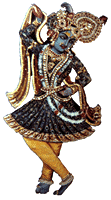 Some enlivening
URLs to visit:
Some enlivening
URLs to visit:
Jaipur and Karoli Deities
http://www.vaisnava.cz/clanek_en.php3?no=109
Govardhan hill
http://www.vaisnava.cz/clanek_en.php3?no=186
Picture galleries from India - totally wonderful
http://www.touruniversal.com/album/india.htm
Take a Transcendental Pilgrimage here to many sacred places
http://www.vaisnava.cz/index_en.php3
Sacred places in India
http://www.vaisnava.cz/ind_en.html
Transcendental Picture Gallery:
http://www.harekrsna.com/gallery/gallery.htm
Various prayers for reading or reciting:
http://www.stephen-knapp.com/a_little_book_of_prayers_mantras_gayatris.htm
Who is who in Vrindavan pastimes
http://www.vrindavan.de/vrindavana.htm
Sri Sri Radha-Krishna Ganoddesh Dipika
http://www.salagram.net/RadhaKrishna-Ganodesh-dipika.html
Bhaktivedanta Museum & Library - New York
http://www.radhagovinda.net/museum/home.htm
Please visit Thailand's Sri Navaratna Museum of Sacred
Natural Wonders on the web
http://www.agt-gems.com/museum.html
See fabled Snake head pearls (Naga Mani), Bamboo stem
pearls (Venu mani), Elephant head pearls (Gaja Mani), rare Shalagram Shila,
genuine Sri Lakshmi Conch, Sri Nava Ratna, Sacred Herbs, Stones, Seeds,
Shells, Trees, Gems, etc., rare items from Vedic antiquity.
All different things in relation to seva
pujan
Our ARTICLES page with links to many aspects
of seva pujan

 News
Item: Now is a VERY good time to utilize this facility
News
Item: Now is a VERY good time to utilize this facility
Pilgrimage to the "Top of
the World"
 Visit Muktinath
or Damodar Kund in Northern Nepal the home of the Shaligram Sila
Visit Muktinath
or Damodar Kund in Northern Nepal the home of the Shaligram Sila
Fly up the Kali-gandaki gorge, the deepest
natural gorge on the planet amid the towering Annapurna range of Himalayas.
An experience of a life-time, with stunning
views that will remain with you treasured for the rest of your life.
Take a quick look here to whet your
appetite....
There are two pilgrimage time periods when
this region is accessible, as the rest of the year it is snow-bound.
Pre-monsoon pilgrimage:
April - May - June
Pre-winter pilgrimage:
End of September - October - November
Kathmandu - Pokhara (By bus or plane - bus
takes six - eight hours, plane takes less than an hour)
Pokhara - Muktinath (by Helicopter) where devotees
get one hour to worship Muktinath and fly back to Pokhara then back to
Kathmandu.
Cost US $400.00 + $40.00 (if ktm-Pok by plane)
For Kathmandu - Pokhara (By bus or plane) Pokhara
- Damodar kunda (by Helicopter) and fly back to Pokhara then back to Kathmandu.
Cost US $850.00 + $40.00 (if ktm-Pok by plane)
Damodar kunda Trekking Itinerary
 Day 01: Arrive at Kathmandu
and transfer to Hotel
Day 01: Arrive at Kathmandu
and transfer to Hotel
 Day 02: Half day sight seeing
tour.
Day 02: Half day sight seeing
tour.
 Day 03: Ply to Pokhara
Day 03: Ply to Pokhara
 Day 04 :Fly Pokhara – Jomsom
and trek to Kagbeni
Day 04 :Fly Pokhara – Jomsom
and trek to Kagbeni
 Day 05: Kagbeni - Tashukang
O/N Camp
Day 05: Kagbeni - Tashukang
O/N Camp
 Day 04: Tashukang - Tetang
O/N Camp
Day 04: Tashukang - Tetang
O/N Camp
 Day 05: Tetang - Tange O/N
Camp
Day 05: Tetang - Tange O/N
Camp
 Day 06: Tange - Surkhang
O/N Camp
Day 06: Tange - Surkhang
O/N Camp
 Day 07: Surkhang – Luri
O/N Camp
Day 07: Surkhang – Luri
O/N Camp
 Day 08: Lur i- Bas Khola
O/N Camp
Day 08: Lur i- Bas Khola
O/N Camp
 Day 09: Bas Khola – Damodar
Kundai O/N Camp
Day 09: Bas Khola – Damodar
Kundai O/N Camp
 Day 10: Damodar Kunda- Luri
O/N Camp
Day 10: Damodar Kunda- Luri
O/N Camp
 Day 11: Luri - Ten O/N Camp
Day 11: Luri - Ten O/N Camp
 Day 12: Ten – Tetang O/N
Camp
Day 12: Ten – Tetang O/N
Camp
 Day 13: Tetang- Muktinath
Day 13: Tetang- Muktinath
 Day 14: Muktinath-Jomsom
Day 14: Muktinath-Jomsom
 Day 15: Jomsom- Pokhara
Day 15: Jomsom- Pokhara
 Day 16: Pokhara- Kathamndu
and transfer to hotel
Day 16: Pokhara- Kathamndu
and transfer to hotel
 Day 17: Rest and explore
your self.
Day 17: Rest and explore
your self.
 Day 18: Fly back to home.
Day 18: Fly back to home.
Details:
· Special Permit
for 10 days US$ 700.00 Per Person & above 10 days every day 70.00 US$
more extra.
· For Liaison
officer expenses have to pay by clients
· Client (s)
should have fill up all form for permit with in 15 days before, departure
for trekking
Cost - US $ 2600.00 per person for group of 5 people (Special
permit fee included)
Cost Includes:
a) All domestic air and land fares within Nepal.
b) All three course meals in trekking days (not in hotels in Katmandu)
c) All staff and trekking leader wages included.
d) 4 nights at Kathmandu and 1 night in Pokhara on Bed and Breakfast.
e) Departure and arrival transportation.
Cost does not include.
a) Visa fee - which will be purchased at your home country.
b) Special permit fee of Upper Mustang (US$700. - as of August 2003
we are now getting this Permit @ US$350. each)
c) Private and Personal Expenses.
d) Tips and donations that you may feel obliged to give along the way......
For those in doubt of ridiculous price of Special trekking permit, sadly
these are the prices for such a remote area as Upper-Mustang. The following
URLs are Nepali Government sites supporting and confirming the US$ 700
cost.http://www.manang.com/Trekking%20Permit.htm
and http://www.project-himalaya.com/info-visa.html
and http://www.buddhatreks.com/nepal/trekking/trekking-permit.htmsorry
!!!
(presently we are getting these permits for US $350 each 8th Aug
2003 - get back to us NOW.)
For Enquiries/Inquiries Bookings send E-mail
To get some idea of the views etc please visit HERE: Visit
Shaligram Tirtha

Have a Happy 2005
...may it be, healthy and prosperous
in every possible way

Sri swayam-vyakta
saligram silas ki jai
 Newsletters
On-line:
Newsletters
On-line:
 #007 - Gaura
Purnima 2005
#007 - Gaura
Purnima 2005
 #006 - Kartik
2004
#006 - Kartik
2004
 #005 - April
2004
#005 - April
2004
 #004 - Dec
31st 2003 - 01st Jan 2004
#004 - Dec
31st 2003 - 01st Jan 2004
 #003 - Sept
2003
#003 - Sept
2003
 #002 - July
2003
#002 - July
2003
 #001 - April
2003
#001 - April
2003


Seeing is believing...

Cheapest and best web-hosting - click on the banner above
Starting at 1Gb or 2 Gb space for one or two years @ just
US$7.50 per month

A Grateful Word to our Supporters

 ...Outro'
...Outro'
Personally we find that so many devotees
are inspiring us in so many different ways, by the grace of the Lord. Especially
I'd like to thank HDG Srila A.C. Bhaktivedanta Swami Prabhupad for saving
my very life, and to HH Jayapataka Swami and HH Indradyumna Swami for all
the support and encouragement in seva pujan. There are literally hundreds
who have helped in this humble service of ours here, Paramseva dasa was
the catalyst for the web-site, Hrsikeshananda prabhu has kindly sponsored
the site and maintains it financially (kindly just paid for another two
years), so without his help it wouldn't be, and similarly for the mirror
site Tirtharaj prabhu allowed us space and hosted us for free for some
time with www.hknet.org.nz to both these devotees we are so much indebted.
Now we are kindly sponsored by Bhakta Gary Kearns and Yagnesh Rajani (kindly
just paid for another two years) on www.hknet.org.nz
on a huge new host - plenty of bandwidth. There are so many others who
have and are helping so much with articles, gifting Silas, books, and paraphernalia,
and support; special thanks to Gaura Keshava prabhu ACBSP, Ramadasa prabhu
ACBSP,
Kurma prabhu ACBSP, Hari Sauri prabhu ACBSP, Sukadev prabhu ACBSP, Bhaktisiddhanta
swami JPS, Ameyatma prabhu PVS, Aisvarya prabhu HDG, Jvala Nrsimha prabhu
IDS, Matsya Avatara prabhu BTS, Mathura prabhu, Kailash mataji, Hamsa Avatara
prabhu, Jagjeevan prabhu and Sudevi mataji MVG, Vikram and Aasha Murthy,
and mother Neeta Sharma and Mukunda Khatiwada, Krishna Akilesha prabhu,
and my eldest daugther Kirtida Sundari (for doing so much typing of articles)
to name but a few. Sarv-lok vaishnavebhyo namo namah so as not to miss
anyone, as we so much appreciate all of you who are receiving this newsletter,
otherwise we wouldn't do all this, thank you so much for just being part
of it.
A special thanks to my Vrijbasi son
Gaura Gopal who kindly paid for ticket to go to India just because he wanted
someone to go with, that was so nice. Thanks also to all those devotees;
Bal & Laxmi, Sikhandi & Bhagavati, Priyanka Prakash, Yagnesh Rajani,
Gary Kearns, Devang & Dipti, Kailash mataji, Vijay Gopikesh prabhu,
Bhakta Greg Nichol, The Metha family, Amit Karanji, Taravali mataji for
covering all the other expenses and items for the Saligram puja.
Also thanks to all the devotees we
met on our yatra who helped to make it such a wonderful experience all
round. Krishna is so kind that He has given such wonderful devotees to
associate with, we are more than ever, eternally indebted to both, Krishna
and His parishad - devotees.
Indeed, many thanks to all the readers
who have one way or another subscribed to Sri Shaligram Tirtha Pradarshini
newsletter. Your interest and support makes this service possible. Those
wishing to contribute in any way to this 'Net-work, send articles, and
or information please do so by contacting me here ... mailto:salagram@xtra.co.nz
By the grace of the Lord and His devotees
at the BBT we have also been given permission to use any BBTI pictures
throughout the site(s)
Copyright ©2005 The Bhaktivedanta Book Trust
International, on the web at www.krishna.com.
Used with permission.
We are very grateful to our sponsors'
donations that help maintain this and similar devotional service, especially
on a regular basis, so again and again thank you. ...for real I couldn't
do it without you.
If anyone would like to send donations
to help maintain this and similar work,
especially on a regular basis please
contact me here also ...

Every little is VERY much appreciated,
and is what allows the service to continue regularly. Thanx
Donations can be made on-line at http://www.hknet.org.nz/
or through http://www.salagram.net/sstp-1.html
or go direct to our link below, all through our PayPal account.




After some feedback from our readers
we are trying to maintain that the newsletter go out Quarterly, (four times
a year - April, July, Sept, Dec). I hope that this is okay with everyone.
See you in a couple of weeks.
//
(@@)
_____ooO_(_)_Ooo_________________________________
|______|_____|_____|_____|_____|_____|_____|_____|
|___|____|_____|_____|_____|_____|_____|_____|____|
|_____|_____Please
pardon the intrusion_|____|______|
*Legalese -- This newsletter or the
notification is NEVER sent out unsolicited. If you are receiving this for
an unknown reason, maybe it's because of a friend giving us your address.
We do not buy lists or gather them via "Harvesting software(s)", nor will
we ever give/sell your address to anybody. If you would rather NOT receive
mail from us, please send us a message saying Unsubscribe, or Remove -
and we will do the needful immediately. We apologize for any inconvenience
caused.
If somehow you are receiving this double
- ie., at home and in the office please let me know, and your preferential
option =>:-) JTCd
_/_/_/_/_/_/_/_/_/_/_/_/_/_/_/_/_/_/_/_/_/_/_/_/_/_/_/_/_/_/_/_/_/

***************************************************************
* compiled
by Purohit JAya Tirtha ChAran dAsan
*
(a.k.a Jaya Tirtha Charan dasa = JTCd)
* jtcd@xtra.co.nz
* salagram@xtra.co.nz
*
**************************************************************
* Sri
Shaligram Tirtha Pradarshini Homepage
* http://www.salagram.net/Sri-Shaligram-Tirtha.htm
* http://www.hknet.org.nz/Sri-Shaligram-Tirtha.htm
* http://www.salagram.net/index.html
* http://www.hknet.org.nz/index.html
**************************************************************












 ...
...







































 Some enlivening
URLs to visit:
Some enlivening
URLs to visit:
 Visit Muktinath
or Damodar Kund in Northern Nepal the home of the Shaligram Sila
Visit Muktinath
or Damodar Kund in Northern Nepal the home of the Shaligram Sila




